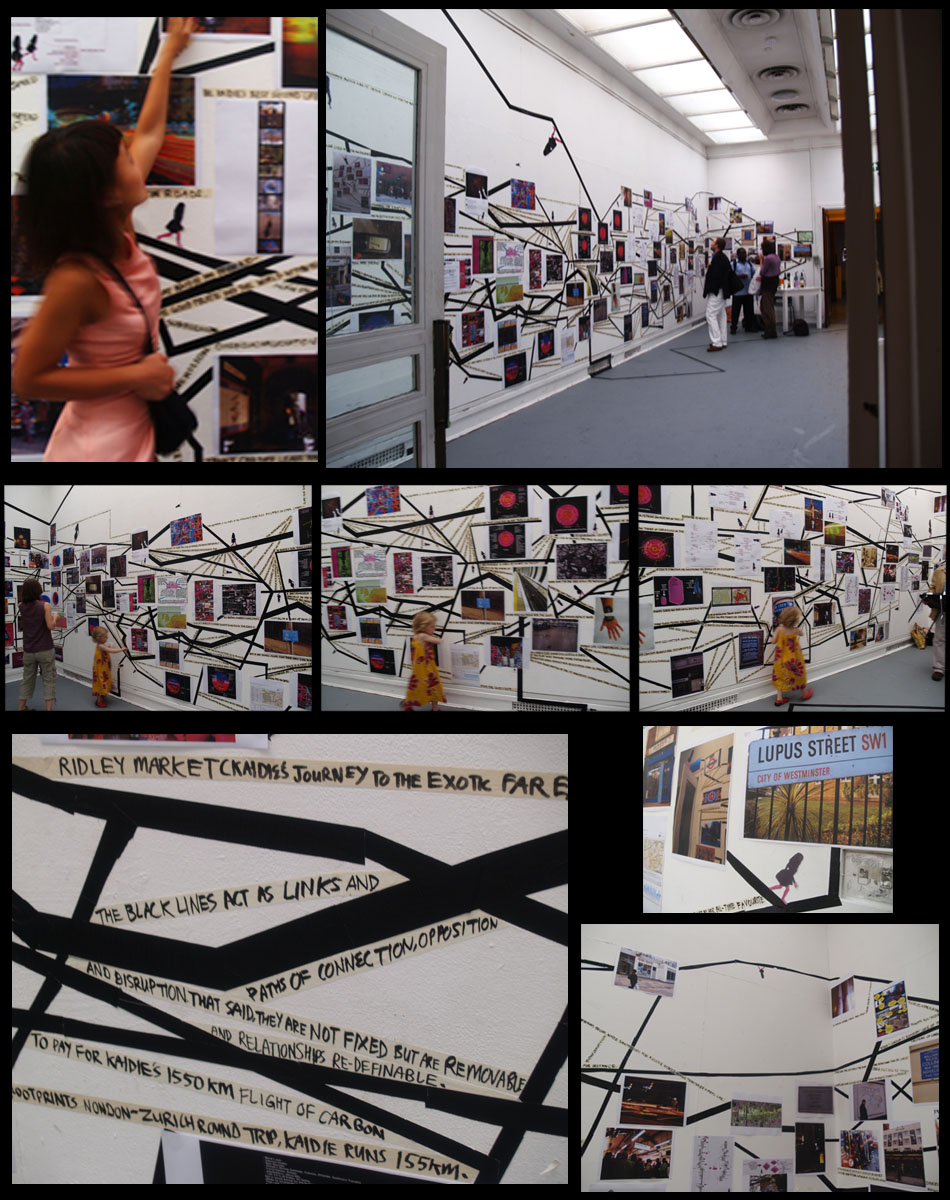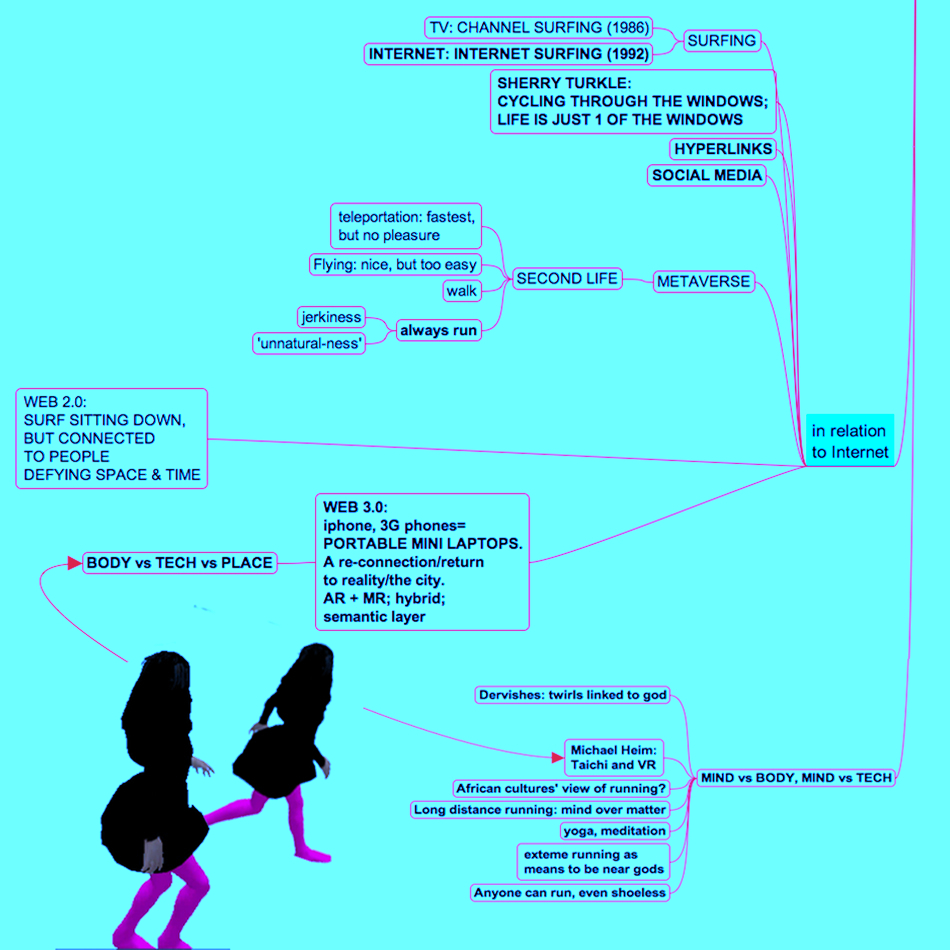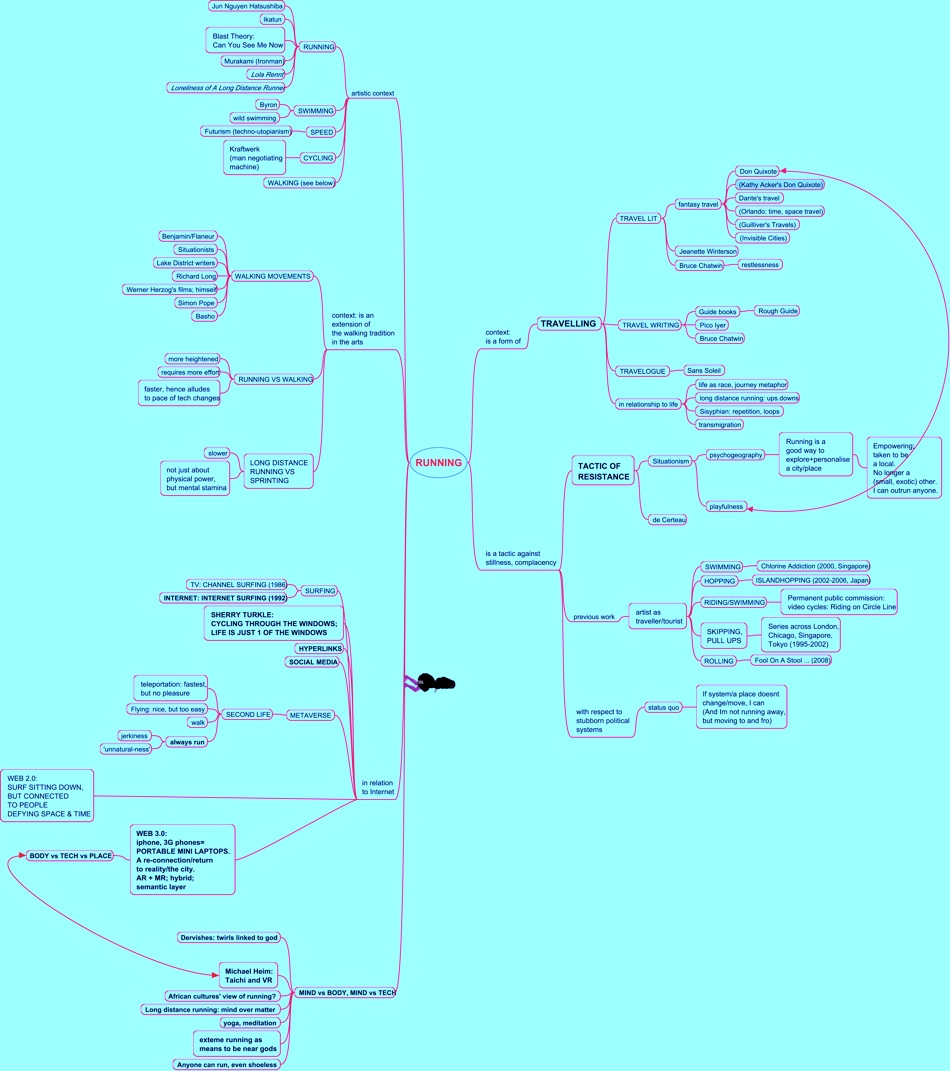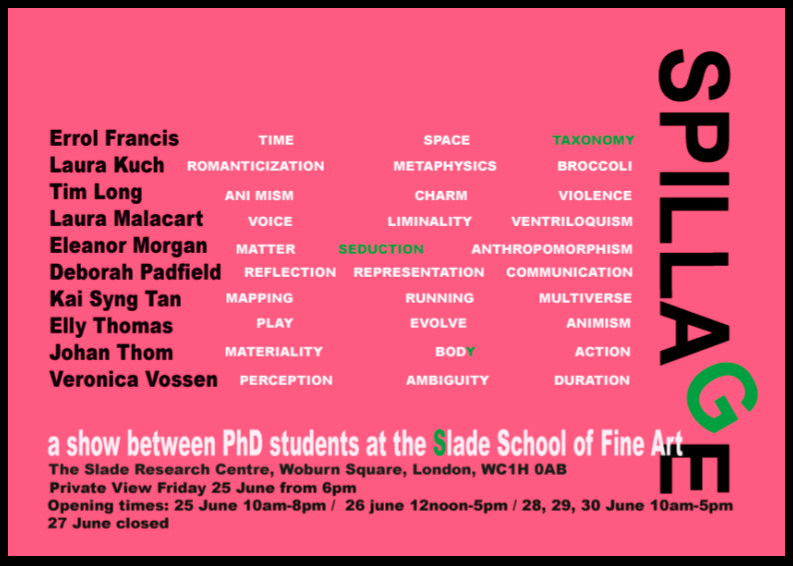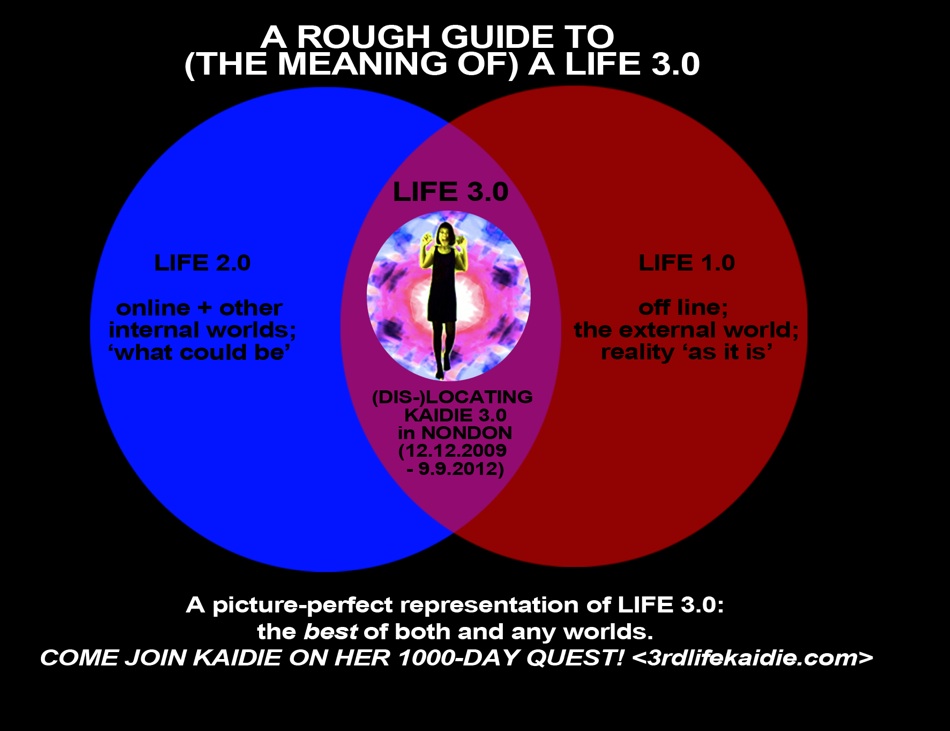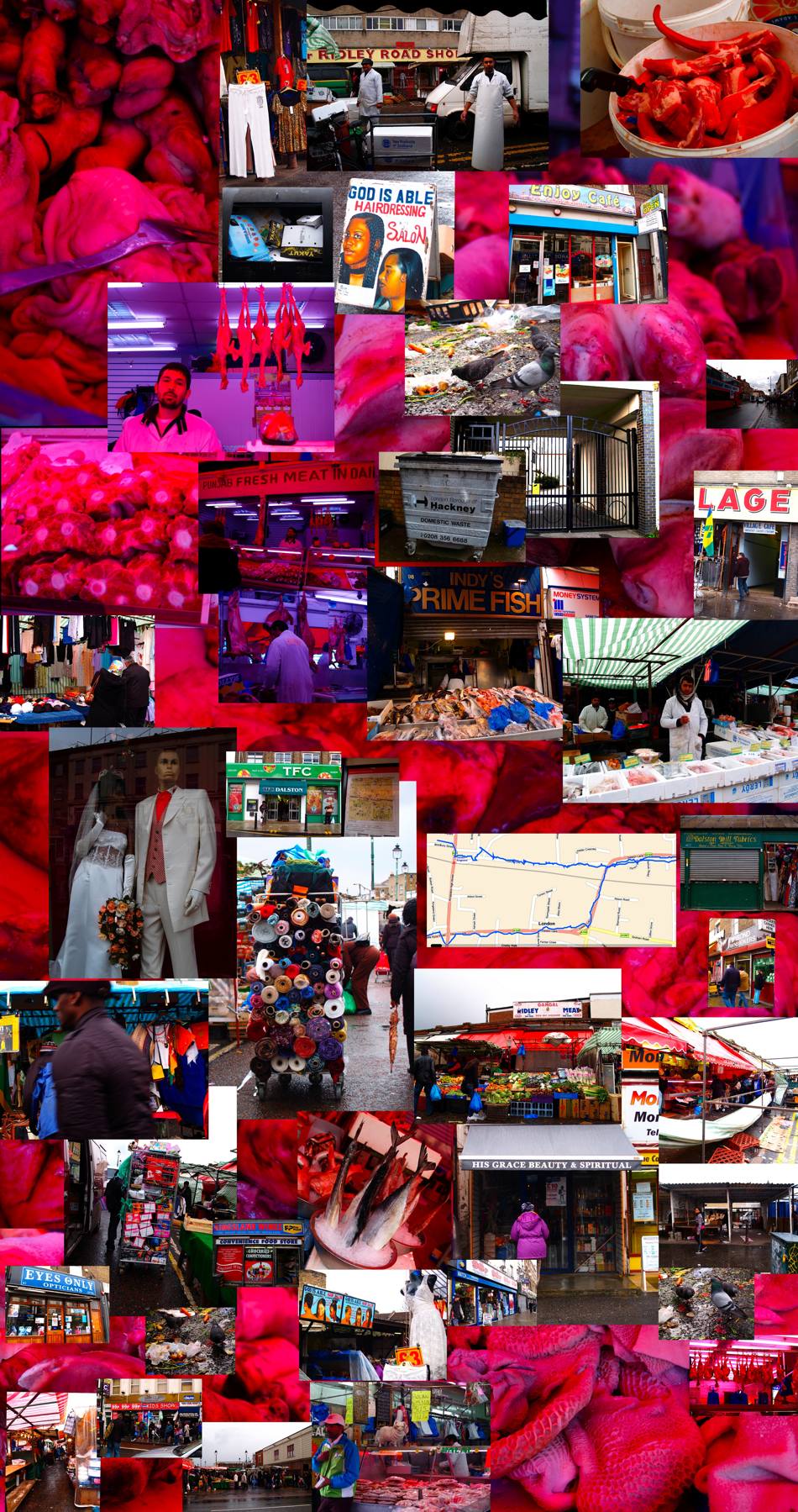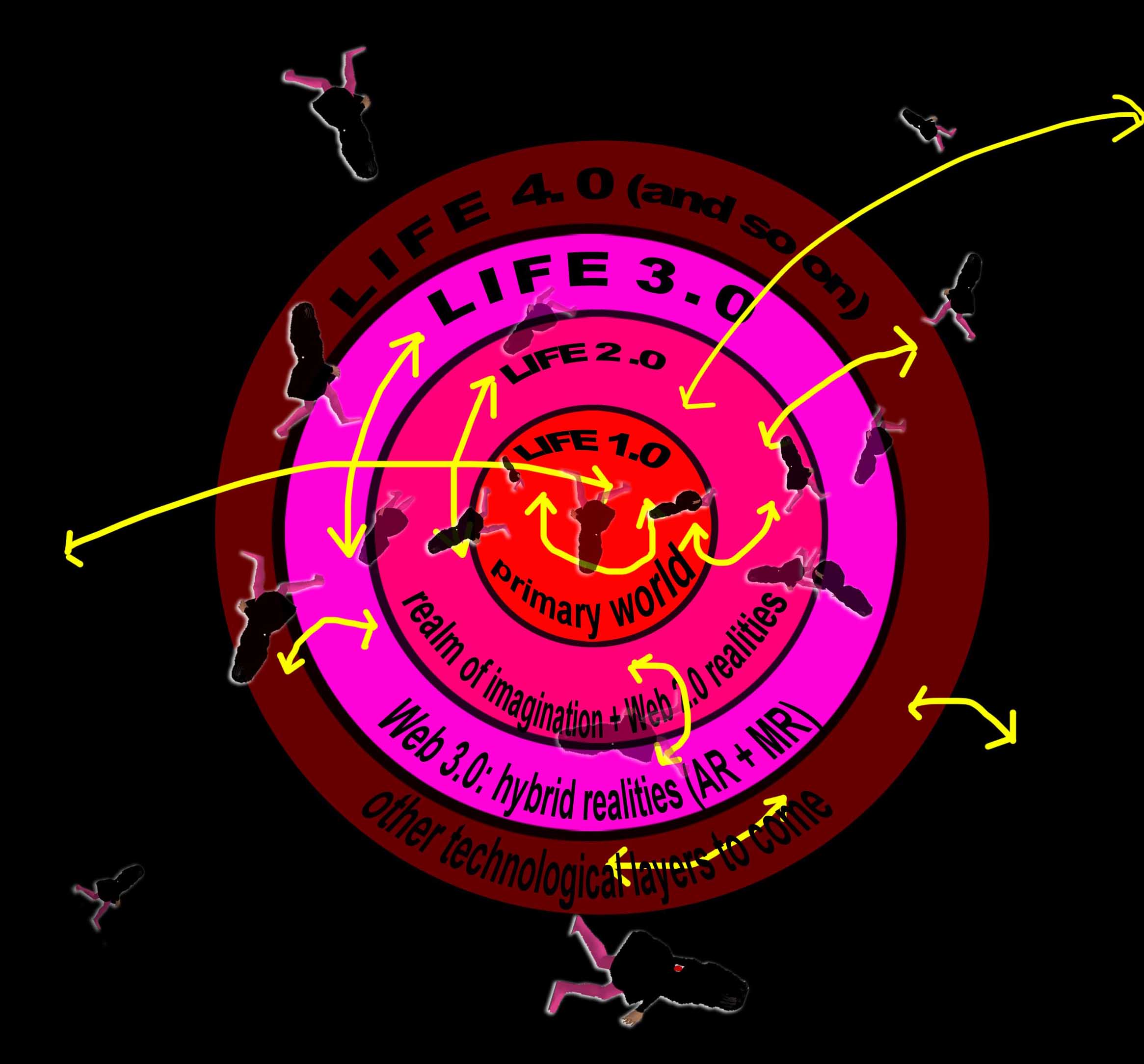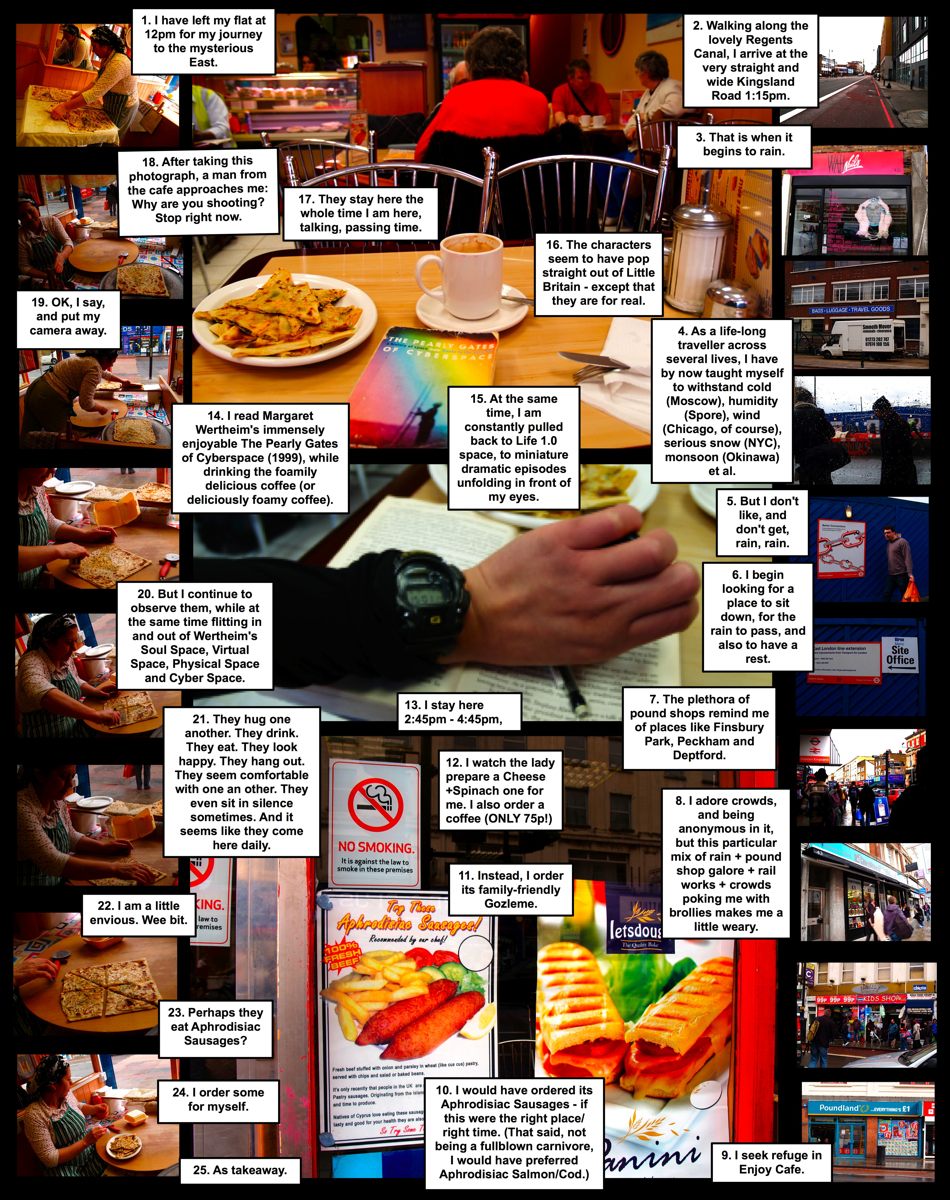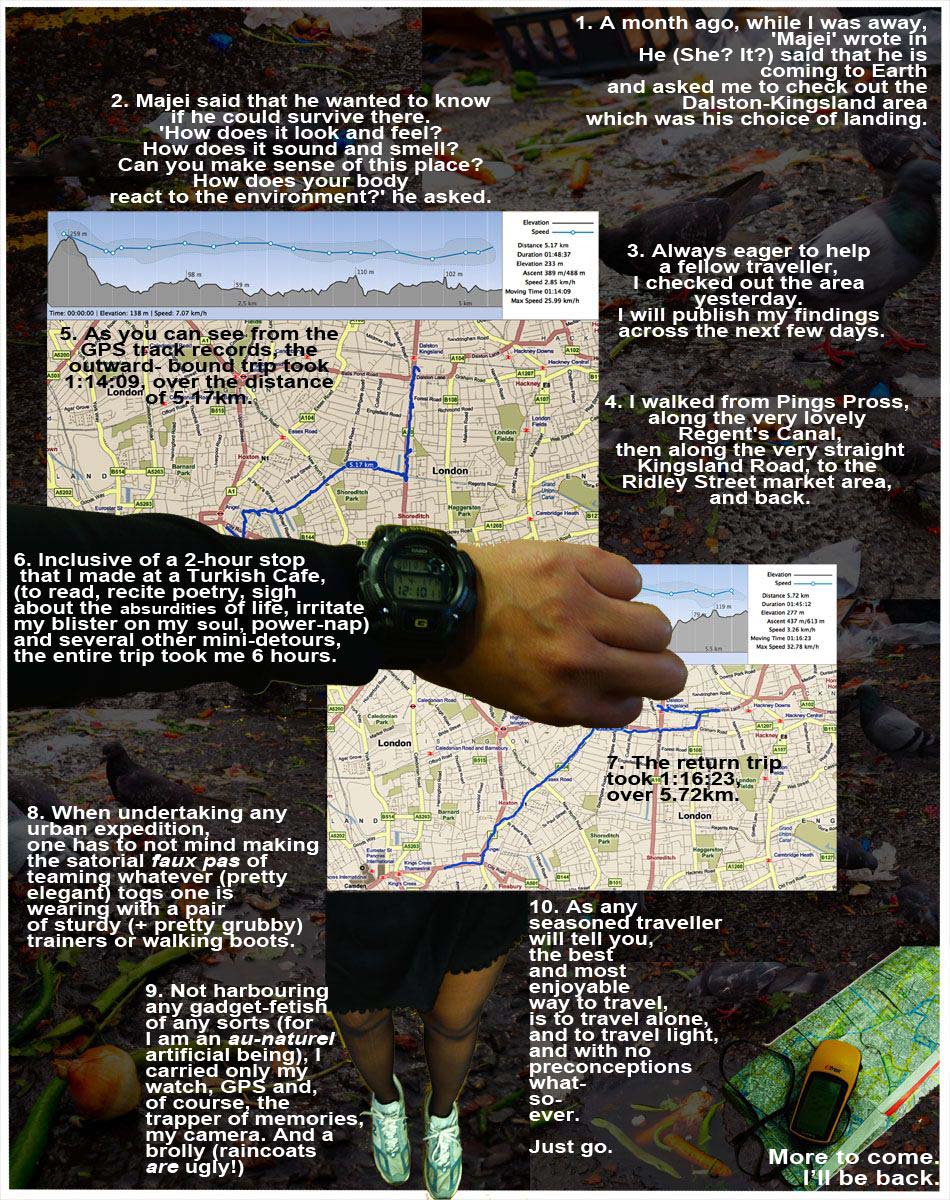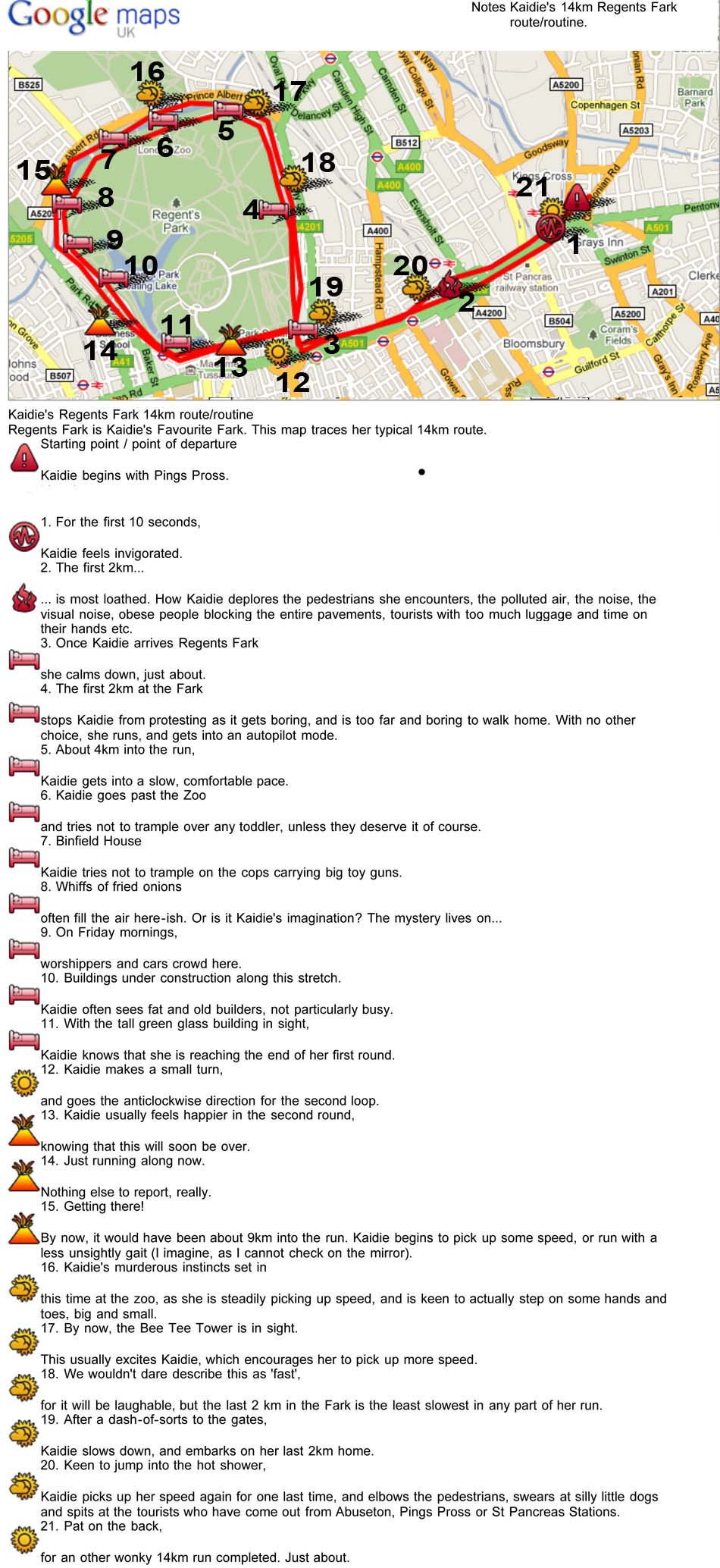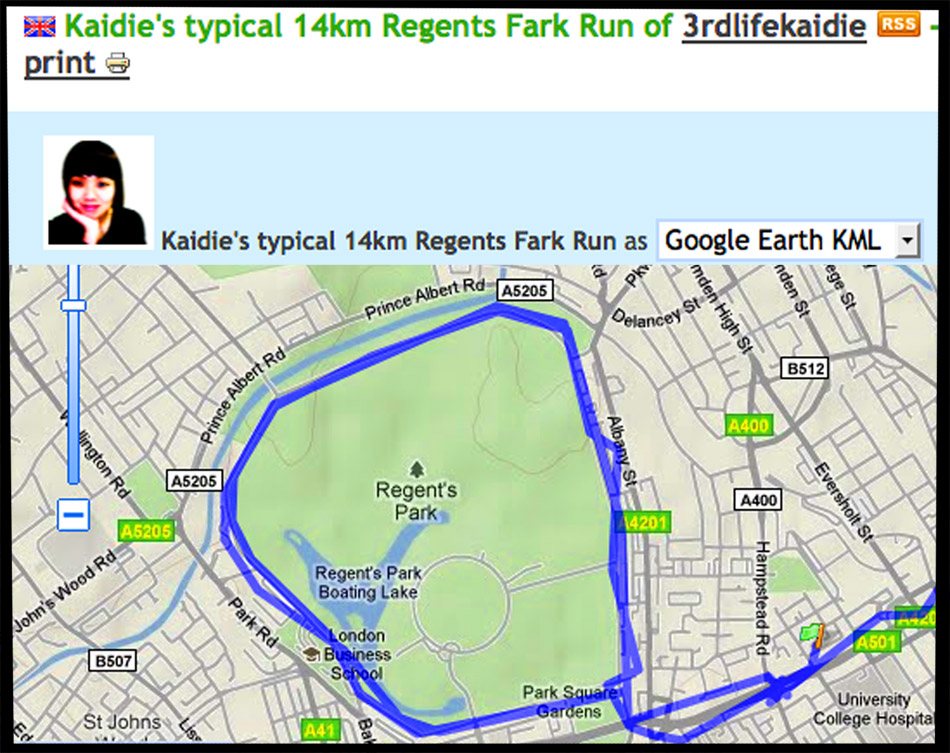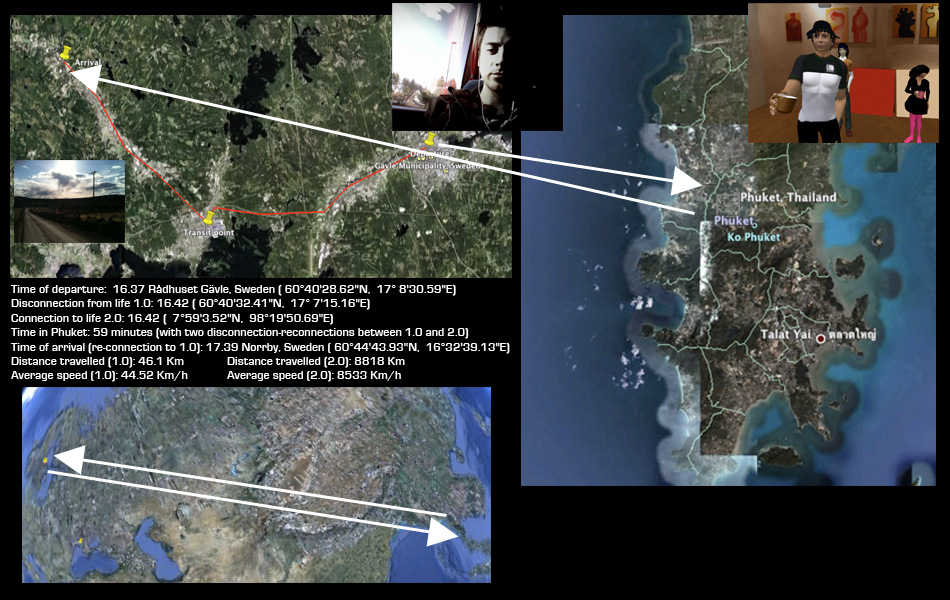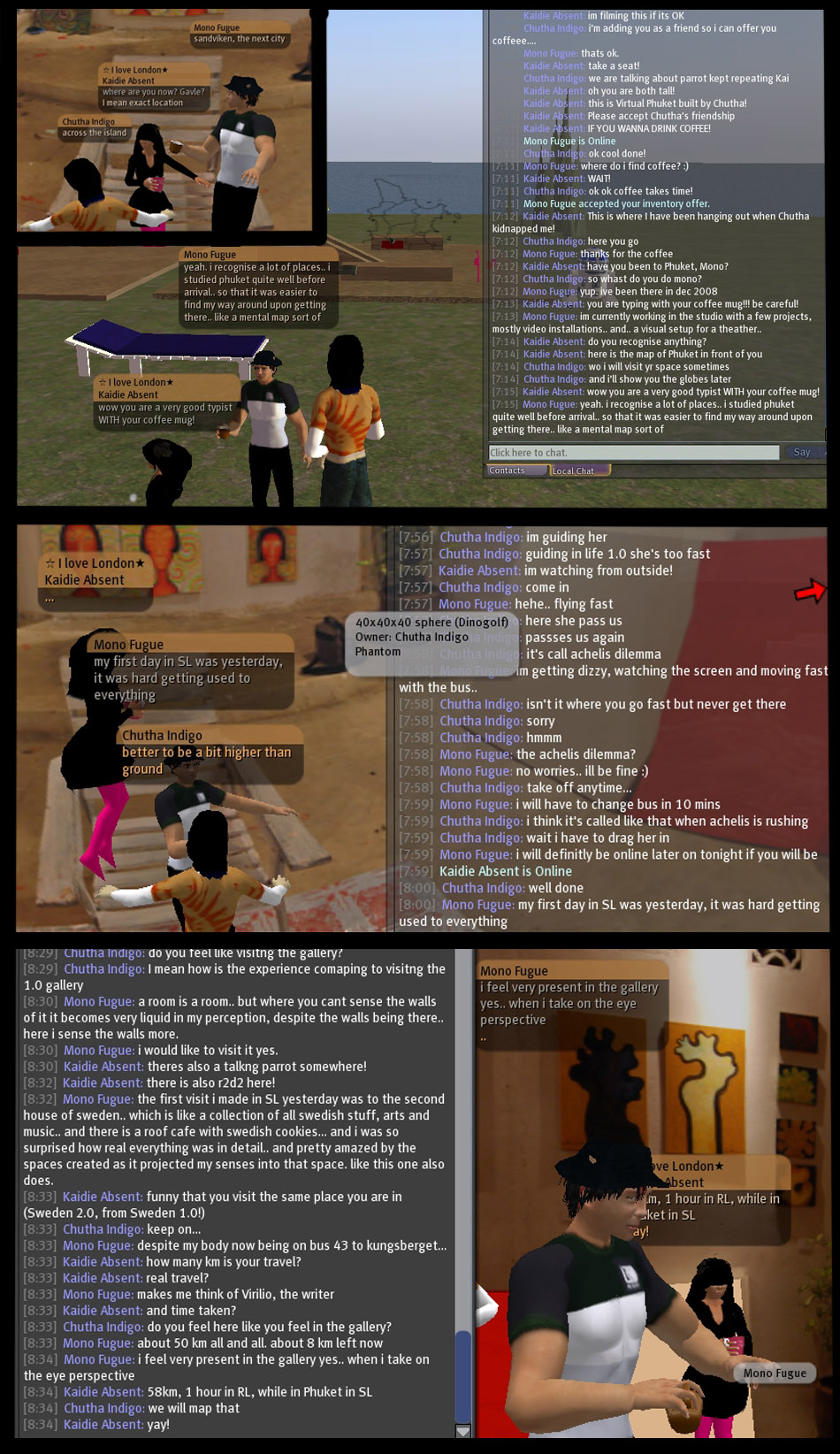FOLLOW KAIDIE ON THE BLACK PATH AND DISCOVER KAIDIE’S MULTILAYERED MIXED-REALITY: Navigating Kaidie’s Metamap Show #7
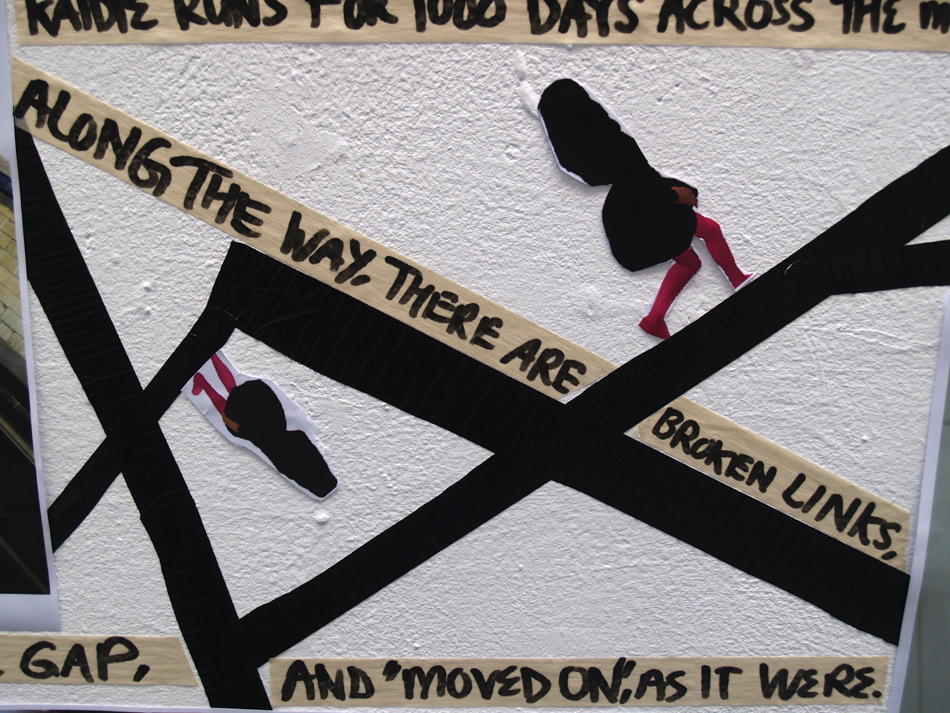 Installed at the PhD show (25-30 June, Nondon), our metamap consists of 120 images and maps that we have created so far. It attempts to draw relationships between the various maps. It is also a map/documentation of our trials and erros thus far to articulate our cosmology/cosmologies. The 14-metre map also itself becomes a landscape, with small cutouts of Kaidie (or Kaidie’s avatar) running all over the wall and floor. Hence, apart from tthe graphical representations of Kaidie on many of the A3 sheets of images, the paper cutouts of Kaidie-s ’emerge’, or rather, burst out into meatspace; and, apart from the 2D plane of the wall, Kaidie runs into the 3D real world of the Slade Research Centre (if the art world could be called ‘real’, that is), along the stairwell, lift, loo and even out into the streets. Here is one (more) map that maps Kaidie’s journeys. Follow the black lines and see where she leads you!
Installed at the PhD show (25-30 June, Nondon), our metamap consists of 120 images and maps that we have created so far. It attempts to draw relationships between the various maps. It is also a map/documentation of our trials and erros thus far to articulate our cosmology/cosmologies. The 14-metre map also itself becomes a landscape, with small cutouts of Kaidie (or Kaidie’s avatar) running all over the wall and floor. Hence, apart from tthe graphical representations of Kaidie on many of the A3 sheets of images, the paper cutouts of Kaidie-s ’emerge’, or rather, burst out into meatspace; and, apart from the 2D plane of the wall, Kaidie runs into the 3D real world of the Slade Research Centre (if the art world could be called ‘real’, that is), along the stairwell, lift, loo and even out into the streets. Here is one (more) map that maps Kaidie’s journeys. Follow the black lines and see where she leads you!
A LIFE 2.0 RE-PRESENTATION OF A LIFE 1.0 SHOW THAT IS ENDING IN A FEW HOURS: Kaidie’s metamap exhibition #6.
Where do statues go after they die? Statues die when people stop looking at them (Chris Marker and Alain Resnais, 1953). Kaidie’s metamap is of a less resilient material than bronze, and, like Kaidie, has a prescribed lifespan. It begins dying this evening 17:00hrs, and from 11:00hrs tomorrow (after our morning run), we will remove the papers, tapes, blu tacks, glue dots, marker pen marks, other marks, tracks, traces, bits, pieces, things, remnants, et ceteras. We will paint over the walls and floors where we had been, and leave the space as we found it, as if we had never been there, clearing all paths, as if it had never known existence in the first place (good for it) (for its own good).
That things die, that they die from one dimension, that they do not last, that they are one-offs, that they are transient and are not foolishly forever, that they can live on – if we so allow them to – in the realm of imagination, perhaps ever/even more animatedly, ferociously and zestfully, is a concept that we quite adore. (We – you, my Dear Readers, and us- have been there before, when we paid a pilgrimage to Heidiland in a bid to visit the legendary Heidi, who was all but absent, and how we were relieved that she could not be found in Life 1.0, for it only strengthens her presence in our Life 2.0). We relish in the cruelty of this, as we adore how it allows us to train and celebrate the/our power of imagination. (‘I’m wondering what this all means to you’, he asks. I am silent. ‘You are immaterial; you do not exist. In fact, you are already dead,’ I want to say, which to my mind is not negative, in our same Heidi-logic, but which would inevitably be taken to be otherwise. So I keep silent.)
The work dies from Life 1.0, our primary world, but/and migrates to / returns to / re-starts in Life 2.0, in the virtual and imaginary realm, and exists as if it has done all this while, independent of the one in the physical world. One is not lesser than the other. To be pedantic, the Life 1.0 metamap in the exhibition ‘came from’ Life 2.0 in the ‘first place’, with the 120 maps and images created on the screen, and having previously only existed in Cyberspace. Already, even as it is alive, we are re-creating Life 2.0 re-presentations of it, in a parallel realm. The work is the same work in either lives, but the Life 1.0 ‘version’ also completely differs and is independent of the Life 2.0 one. In fact, there is no ‘essential’ work. When we run restlessly between Life 1.0 and Life 2.0, we are re-creating the/a work again.
2nd row top left: photograph of Kaidie at work by fellow artist-exhibitor, Laura Malacart. Beside that is a sketch by Kaidie of the work, before she began. Middle: Kaidie, quite knackered by now, poses with fellow artists and exhibitors Deborah Padfield and Errol Francis at the end of the humid evening of the opening 25 June. in the next picture, Errol competes with Kaidie for Person With Most Number Of Countable and Accountable Teeth Award 2010. We are fighting neck to neck, shoulder to shoulder, and- of course we are expecting this- teeth to teeth, a tooth for a tooth, gum for gum. Who do you think should win? Bottom right: Pink poster Spillage indicates the title of the show. Bottom left: Kaidie’s hand-made wall text for her new hand-made wall-text-installation, 24 June 2010, 1 day before show opened. The masking tape on the wall were to be all licked up, of course. Kaidie’s Life 3.0 ecosystem tolerates no wastage (most of the time). Check out the ‘paper tippex’ on the right hand side of the wall text as well (since there is no undo button in Life 1.0).
LAST 2 DAYS TO CATCH KAIDIE’S FIRST LIFE 1.0 INSTALLATION! Slade Centre of Research, WC1H 0AB. Kaidie’s metamap exhibition #5.
Across a 14m-wide wall, Kaidie works on site across 9 days to create a metamap consisting of 120 maps and images, that attempts to map her transdimensional run. This show departs from Kaidie’s recent works in that it utilises no multimedia, and that Kaidie installed this by herselves, got down on all fours and was all hands-on and filthy, screaming at no assistants except herselves. Slade Centre 25-30 June 2010, Nondon.
The baby in the triptych in the middle fingers the trails and links of Kaidie’s wall map – good. Then she goes on to spill red wine and pringles on my floor – no good, but she’s a baby, and we are so magnanimous as to hold no grudges against babies. And then she cries loudly, as if she was the victim! – oh, NO GOOD, but still understandable in the scheme of things (yes we are rational beings). But that is not the punchline – the adults responsible for the tot did no thing to help clean up, and escaped! – NOOO GOOD. My Dear Readers, we are sure that you have encountered ultra-righteous people with a strong sense of entitlement, who act as if they are the only on earth to have ever reproduced (THE REST OF US – if you did not already know – ARE ORPHANS MADE FROM PLAYDOH). So we – speaking as self-righteous runners and figures of imagination – had to stoop on the floor and lick up the pringles+wine+the baby’s tears+dust+hairs (thick, thin, curly, straight, blond, red, brown, black, etc), being ever so keen to store up food and drinks in our system at every opportunity in the middle of the ‘we-are-all-in-this-together’ recession.
Image of Kaidie overstretching herself by Alexandra Gomes during private view 25 June 2010 Friday. (Yes – pink, and its shades, was the order of the evening. Why? Because we have for the past few lifetimes tired of the obligatory black attires at art openings.) THANK YOU ALL for coming to the exhibition thus far, and its opening. More images of opening and exhibition to come – look out if Kaidie has caught you on camera! Did you say and smell of cheese? So, watch this space. Do not move, for soon all this will disappear from Life 1.0. (We will film ourselves de-installing the work, which had taken 9 full days to install, on Thursday in time lapse, and play it backwards, and upload it on Youtube later. Rather terribly exciting isn’t it).
25-30 JUNE: Display of WHY RUN? (WHY NOT?) and other mind+mentalmaps. Slade Centre of Research, Nondon #4
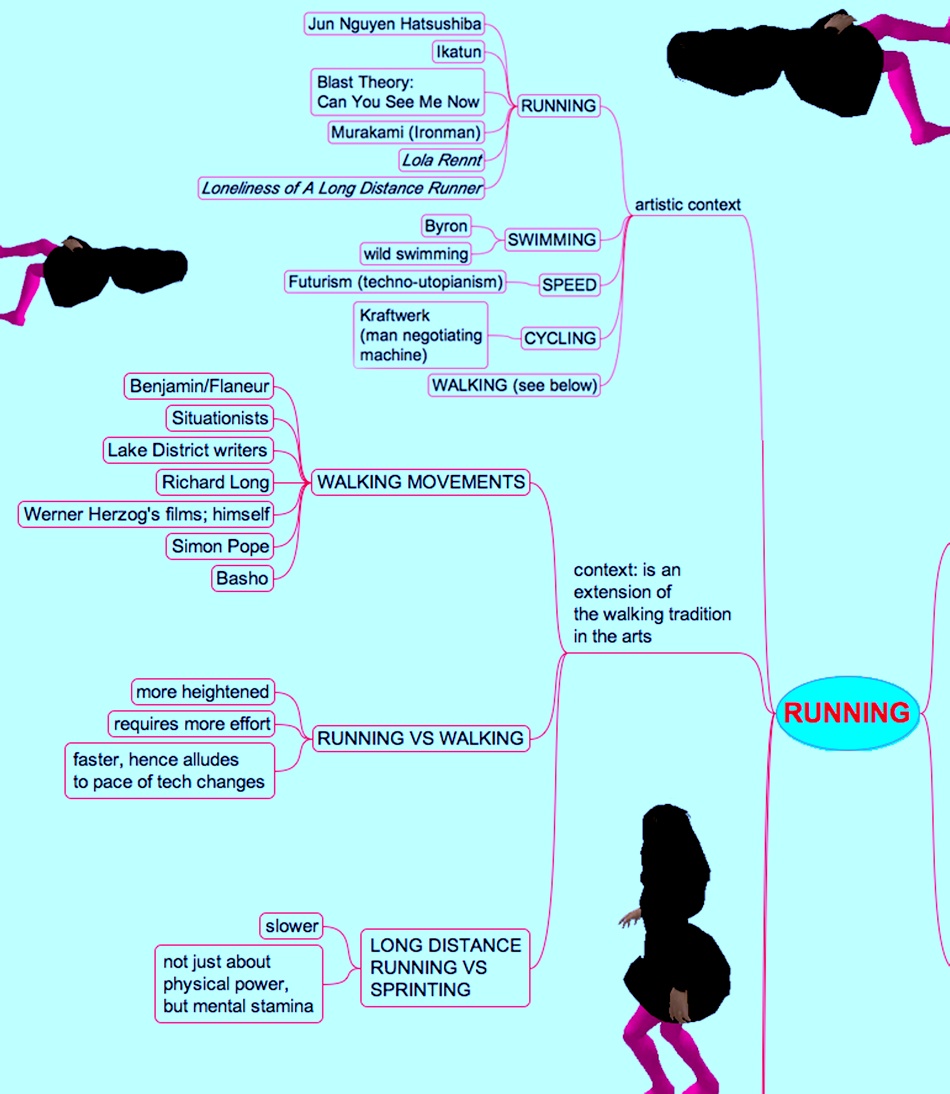
NOTHING COMES FROM NOTHING, AND RUNNING HAS SEVERAL HISTORICAL THREADS.
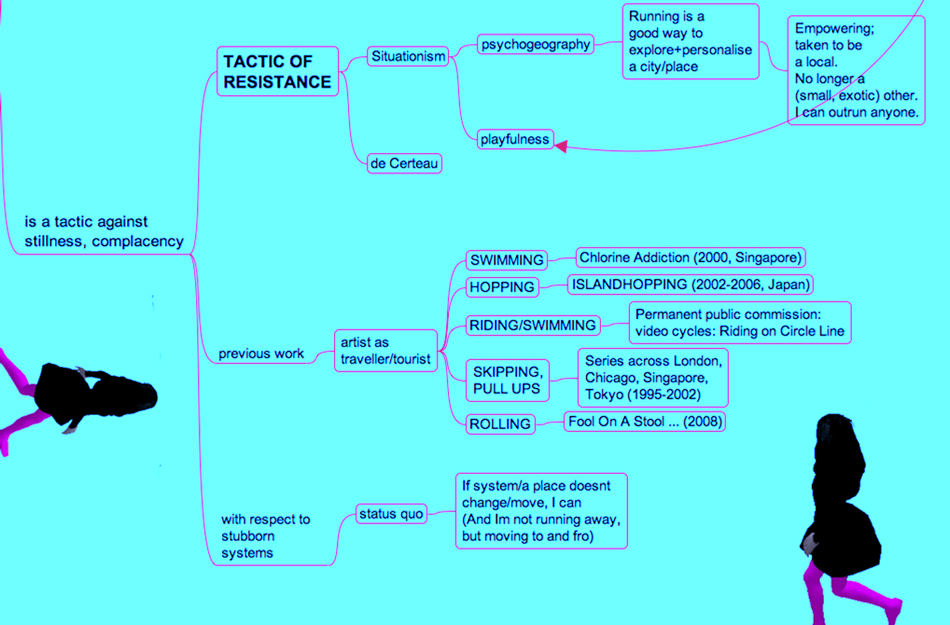
RUNNING AS A SIMPLE, VISCERAL COUNTERPOINT / CRITICAL STRATEGY FOR OUR TECHNOLOGICALLY-MEDIATED REALITY. (PLUS: HULA-HOOPING IN I AM FIT FOR LIFE 2000)
A QUICKYSNEAKYBLURRYMCFLURRY PREVIEW OF KAIDIE’S 120MAP-METAMAP: 25-30 JUNE EXHIBITION #3
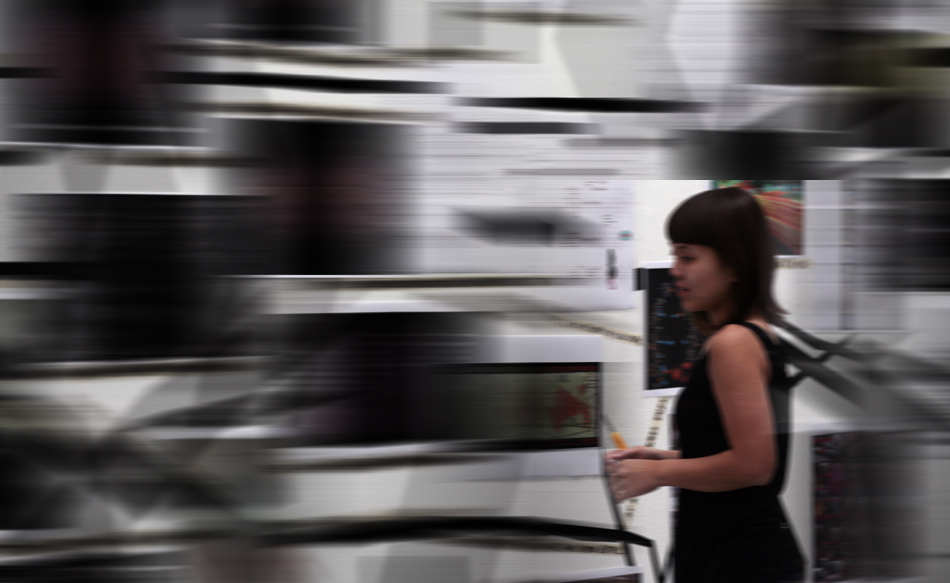
Kaidie hard at work, at the Slade Centre of Research at Woburn Square, creating a metamap of 120 maps of her transdimensional run. Beware, however, of Kaidie's knife that she's holding on her hand - she might slash more than paper if you try to come too close. Keep a critical distance! In this show, there is NO multimedia, NO moving images, no cables and no technical cockups, only penknives, masking tape, gaffer tape, 120 pieces of A3 papers, one 25metre wooden creaky scary ladder that Kaidie has to climb up, one lower sturdier ladder, papercuts, marker pens, cups of foamy coffee (we were supposed to have quit coffee!?), plenty of dust-and-hair (curly, straight, long, short, thick, thin - ALL YIKES!) -collection on Kaidie's jeans as she kneels/prostrates reverently on the dirty floor before her wall, and other analogue goodoldfashioned cockups. Come see for yourself. Original photograph by Laura Malacart 19 June 2010 Nondon, UK.
25-30 JUNE: KAIDIE SHARES A 14-METRE METAMAP OF 120 MAPS OF HER TRANSDIMENSIONAL RUN. Slade Centre of Research, Nondon #2
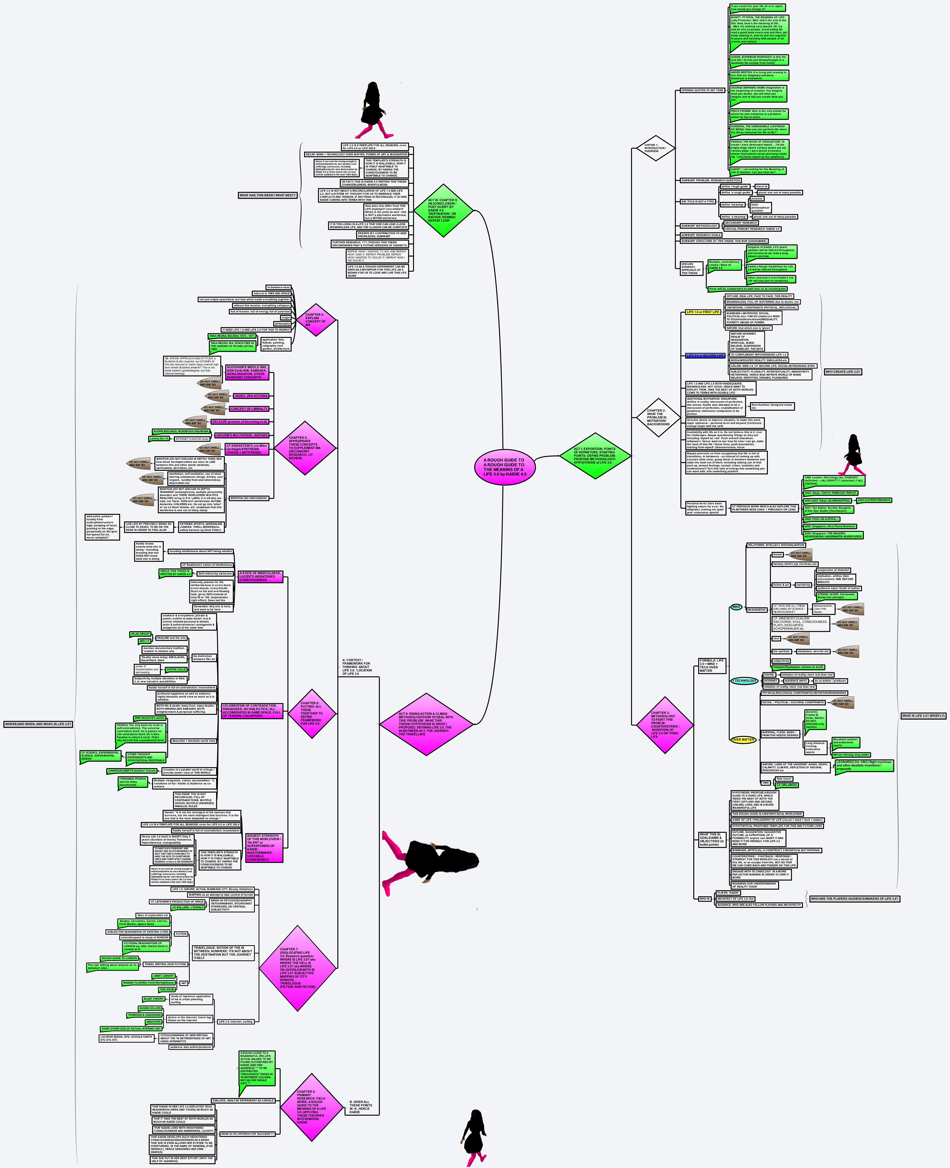
How would a map like this (created before Kaidie's birth in October 2009), be contextualised in Kaidie's wall-installation (June 2010)?
Private view: 25 June evening. Exhibition: 25-30 June. Location: Slade Research Centre Nondon WC1H UK. Opening hours: 9am – 5pm daily except Sunday. Kaidie exhibits her Multiple Mad Meandering Maps + Mandalas of her restless running across Life 1.0 (primary world), Life 2.0 (realm of imagination, Web 2.0 realities) and Life 3.0 (Web 3.0 AR+MR, hybrid reality). As we speak, Kaidie is creating a 14metre-wall-installation, a metamap of her maps of her intradimensional run. In this exhibition, there are 14 PhD and researchers on show with a wide-range of works including performance, sculpture, video installation and sound.
25-30 JUNE: KAIDIE SHARES HER MEANDERINGMADMAPS + MANDALAS. Slade Centre of Research, Nondon #1
What: In this exhibition, there are 13 PhD and researchers on show with a wide-range of works including performance, sculpture, video installation and sound. Private view: 25 June evening. Exhibition: 25-30 June. Location: Slade Research Centre Nondon WC1H UK. Opening hours: 9am – 5pm daily except Sunday.
Kaidie exhibits her Multiple Mad Meandering Maps + Mandalas of her restless running across Life 1.0 (primary world), Life 2.0 (realm of imagination, Web 2.0 realities) and Life 3.0 (Web 3.0 AR+MR, hybrid reality). As we speak, Kaidie is creating a 14metre-wall-installation, a metamap of her maps of her intradimensional run. And there is NO multimedia in this new work, only goodoldfashion 2D ‘stuffs’. Can you believe that? Me neither. Well, come see for yourself. (We would have used the adjective ‘Magnificent’, in conjunction with the brilliant Magnificent Maps exhibition at the British Library, but that would not have been very Modest of Me, would it?)
See you around. Literally. Being all-rounded we can bounce ideas off each other. Jolly well.
AS I TURN 6-MONTHS OLD, I REALISE THAT I QUITE ENJOY MY LIFE/LIVES NOW, HERE.
Unbeknownst to me at that time, my visit to Enjoy Cafe is to turn out to be profoundly life-changing. As I turn 6-months old on 12 June 2010, I wash down a dozen of the Aphrodisiac Sausages with Dettol. I am hit – not suddenly, but gradually, nicely, warmly, largo – with a realisation that I quite enjoy my life and lives now, here, in Nondon, in my Life 3.0. I think, and I know, that I enjoy where/when I am, difficult/diverting/frustrating/frivolous as it is. Society celebrates youth, in all its actual and mythological glory/beauty/recklessness/kawaii-ness/innocence (or so-called). I enjoyed being young when I was, but I also enjoy having travelled the journey (detours included) to get here, of being what(ever it is that) I am now, quite tremendously, in all its imperfections/wisdom (or lack thereof)/scars/histories/wear&tear/warts&all. And I enjoy knowing that I am enjoying it.
In all my lives, in Nondon and elsewheres, people have often judged me to be younger than I am. But never once had/have I a desire to deny/lie (although some times I evade, because I some times like to see where it leads me when I am perceived to be more naive than I am, which is not to say that I am with out mature folly). The look of shock (or disgust) by the asker invariably provides me with a (perverse) pleasure. (Allow me to share a couple of incidents with you, my Dear Readers. Incident #1: Last week at Cally Pool: Girl asks me when I step into pool, ‘How old are you?’ Me: ‘Make a guess?’ She: ’19’. I tell her. She looks offended. Keen to restore peace, I ask her: ‘How old are you?’ ’11’, she replies. She is quite a bit taller than me. She looks me up and down. Then, both unclear of how to carry on with the conversation, we swim off in separate directions, in shock. Incident #2: At my local Tesco’s, when asked for my ID, I tell cashier my age. She stares at me, and gets her Supervisor. The women begin staring at me. ‘Perhaps it is what I’m wearing?’, I offer. ‘No, it’s your skin’, supervisor says. ‘Well luckily you are not looking close enough’. So she comes close, barely inches away from me, eyes wide open, examining me. Keen to get my bottle, I endure this unexpected scrutiny for several seconds. ‘What do you eat to look like this?’, she asks, as the cashier beeps my bottle and Tesco’s-branded cheap and nasty cakes. ‘Tesco’s cheap and nasty cakes,’ I reply. Incident #3: He, 18, guessed that I was 22. I said, ‘We could have met when I first came to Nondon, but we might not have recognised each other as you must have been in a pram (and dozy from all that milky binge-drinking).’ I think this is a hilarious image, but he clearly did not.)*
Mind you, I am by no means old, old, but having lived 6 out of my prescribed 32.8-months allowance declares that I am no spring chicken, but a mature summer barbecued pork, sweating in lard. Dripped from the previous years’ roasts.
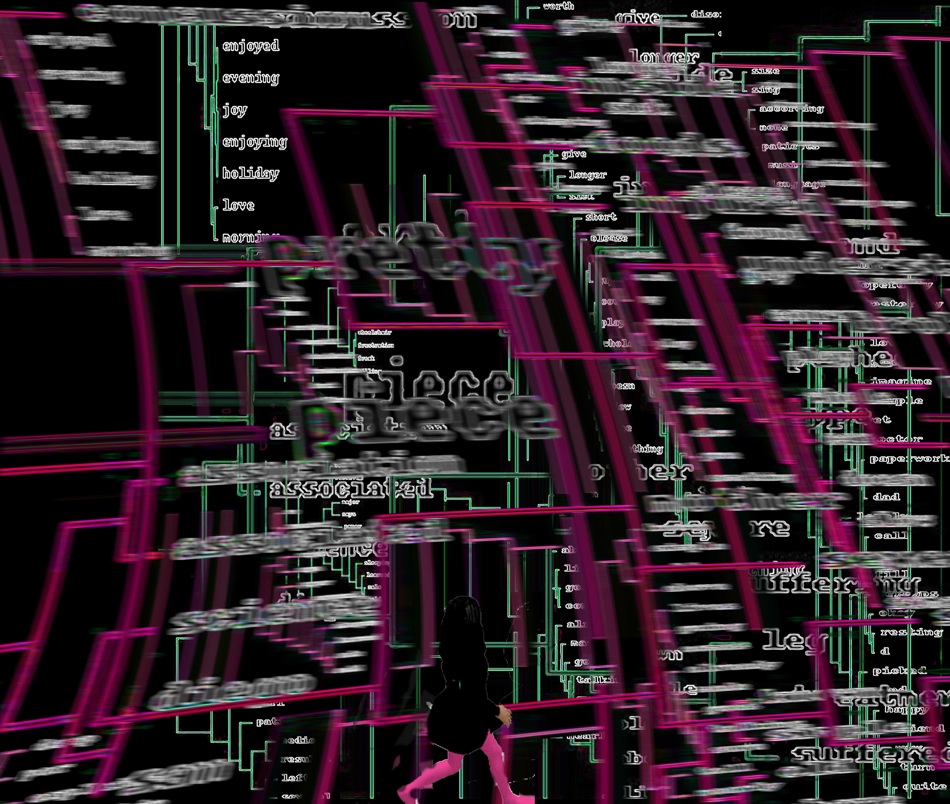
This image has as its source several text-tree diagrammes generated by Dr. Jamie O'Brien from a programme he designed.
More than ever before, I now enjoy many things physically, intellectually and psychologically. My Life 3.0 reality is an augmented one, but with neither sillycone nor sentimentalism. The best part is that I enjoy knowing how much I am able to enjoy what I am enjoying. (A sign of smugness perhaps, or an other indication of a profound delusion. Not unike Quixote’s). And this is not a tautological statement (even though we enjoy tautologies and tautologies enjoy us). Though I have always been an introspective person, this seems an other stage of self-awareness and confidence that would have escaped me at an other age. More than ever before, I now know what I want, when I want it, and how to dispense/use/it, at the dosage that works – what specific phrase of a piece of music I wish to listen to, at what volume, for how many number of loops; what particular type of cheese I wish to savour at a particular moment, to be followed by what particular dessert at what dosage; what particular scene of a film I wish to replay in my head, to evoke or force about a particular emotion (and it is invariably a Herzog or Marker or Tarkovsky scene), at what point to wean myself off an obsession, to say ‘Enough!’ and move on; to know the exact demands of a task/race at hand, and pace myself, so that I do not burn out too quickly, so that I stay focused and clear, but allow myself refuelling and treats when the energy levels dip, and then go for a final push, a sprint, a dash, a be-all-end-all exertion, et al. I also enjoy not knowing, and enjoy knowing that I do not know, and enjoy that anticipation, anxiety, excitement, the waiting (Have you read Barthes’ elegant chapter ‘Waiting’, in A Lover’s Discourse?), the feeling silly, and curiosity. I enjoy doing what I am doing. I enjoy what I am being. I enjoy waking up every morning, excited about confronting my challenges. I enjoy a good challenge, as I always have had all my lives, as they give me a good kick, because I enjoy kicking back, hard. I enjoy wanting something and working hard for it. I enjoy achieving. I enjoy leaving. I enjoy arriving. Most of all I enjoy the process of getting there, even if the arrival is anticlimactic. In fact the arrival will invariably be. I enjoy putting in effort. I would have enjoyed not having to put in any effort, of course, but by now I know how I work, how I have to work, so I do, and I enjoy doing that. I enjoy going to bed at night, having fought the demons, windmills, and myselves and looking forward to the next set of challenges the next day. And the next. I enjoy raising the bar (including raising the Snicker bars into my mouth). I enjoy communicating with my friends in Life 2.0. I enjoy knowing you. I enjoy not knowing you. I enjoy that we may never, and/or may never desire to/need to, meet in Life 1.0. I enjoy that we might have met in Life 1.0, but do not out ourselves, because doing so would spoil everything, your idea of Kaidie, and hers, of you. I enjoy that we meet in Life 2.0. I enjoy that we meet at all. I enjoy that we meet, and share, and run together. I enjoy not knowing the fate/s of Kaidie (except that she must expire 09.09.2012). I enjoy that you play a part in Kaidie’s being. I enjoy being invited to unexpected diversions, as invented by my friends, including you, my Dear Readers, my Collaborators, my Co-creators. I enjoy being Kaidie. I enjoy that Kaidie and Life 3.0 are public properties, and open source systems, and our collective and subjective imagination. I enjoy trying and testing new things. I enjoy going where I hadn’t/ wouldn’t have. I enjoy running with you. I enjoy having virtual running companions on my 1000-day journey. I enjoy exploring new territories and unknown terrain. I enjoy not knowing. I enjoy being surprised. I enjoy that things are not written. I enjoy that Kaidie can be over written by you. I enjoy that Kaidie can be written off by you, and me, or in spite of me. I enjoy that Kaidie’s story in Life 3.0 cannot be facilitated with out your Web 2.0 assistance and good-old-fashioned imagination. I enjoy that Kaidie is not precious, that she will cease to exist, that she is me, but can be any one, any body, real or imagined, that she is fictive, but that she is me as well, that I am her, that you can be her too. I enjoy the smell of my cocoa-butter moisturiser because it smells like superrich vanilla icecream and I want to eat it but I don’t. I enjoy lying on the grass with B, G, S when the sun is shining. I enjoy walking home from Great Marlborough Street with C, and sighting a deflated football on the street and attempting to kick it, only to laugh at it, as if to mock it, but affectionately and not maliciously. I enjoy walking home with J & A from Smithfields when it is more than 20 degrees. I enjoy walking home with B from St Johns Street. I enjoy tension. I enjoy prolonging tension. I enjoy saying hello to the Hispanic cleaners. I enjoyed walking with B again, looking for food, starving, then stuffing my face with a sandwich that had hummous, and something else, and asking B if there is anything on my face, but unfortunately left with no more time to talk more. I enjoy taking time. I enjoy the luxury of time. I enjoy having a short attention span. I enjoy having the physical and mental stamina to endure long journeys/races/lives. I enjoy the sting of wasabi. I enjoy walking at 18 degrees. I enjoy running at 8-12 degrees. I enjoy running in the gym at 16 degrees, because that is the lowest you can go, but the air is still stale and stuffy. I enjoy my shower at 40 degrees. I enjoy swimming in chlorine at 25 degrees. I enjoy my foamy coffee piping hot. I enjoy walking along Commercial Road with G. I enjoyed walking with S along the canal late at night, when I slipped, because I was not wearing my glasses, and where I would not have walked alone at that hour, but together it was lovely, based on a decade of friendship. I enjoyed wandering around Moscow with I as it snowed and we got lost in the circle line. I enjoyed exploring Perth with J, 2 foreigners and strangers looking for a place to go, with out a map, enjoying being lost, together. I enjoyed walking in Suomenlinna with P in a Summer midnight, when it was still bright, albeit chilly. I enjoyed being submerged in the outdoor onsen, in the mountains, when it was cold and raining, holding an umbrella, pitch black, seeing no thing, but comforted by my friends’ laughter, friends who had brought me here because I was flying off the next day. I enjoyed walking with F in Spore in my previous life, and Paris in my current, even though we have both moved on. I enjoy all my long distance flights. I enjoy not sleeping on my long distance flights. I enjoy flying across timezones, political excuses and economic selfishness. I enjoyed my 7-hour bus ride with A, with out sleep, and the subsequent croissants for breakfast, during which exactly two thousand bits of pastry were busily flaking onto the dirty trashy subway station ground, so instead of eating all 2 croissants A had only 1.2, or thereabouts, I gathered. I enjoy running, flying, swimming and living alone. I still enjoy swimming because the chlorine endorphins kick in surely and quickly. I enjoyed running in Tokyo, Fukuoka, Beppu, Oxford, Spore and Winterthur. I enjoy getting jealous of Kaidie when B tells me that he might prefer to go out with the Life 2.0, virtual Kaidie than the Life 1.0 me. I enjoy the airconditioning in the British Library and Wellcome Institute. I enjoy sweating when working out. I enjoy being underestimated. I enjoy proving myself. I enjoy proving myself wrong. I enjoy learning. I enjoy perfect pitch and hearing. I enjoy being a little short-sighted, so I see things in a slight blur when too far away. I enjoy fuzzy logic. I enjoy ambiguity. I enjoy dry humour. I enjoyed playing the piano for 11 years. I enjoy imagining an other life as a concert pianist. I enjoy walking in Regents Fark with A, not knowing where we were going, if any where, but even if no where, that was fine, as it was, as it is. I enjoyed the warmth of my filmmaker-activist friends in Sderot who were passionate about peace. I enjoyed their sincerity and kindness after I endured endless searches in order to get onto el al opening my bags emptying my hand luggage removing my battery from my laptop showing them my files body searched many times passports flipped endless questions asked. I enjoy imagining Y running in Hyde Park, although not with me. I enjoy the smell of fresh bread. I enjoy eating at least 1 banana daily. I enjoy salmon and brie. I enjoy champagne with pancakes. I enjoy olives and corn and niceness. I enjoy the smell of B’s hair. I enjoy smells. I enjoy smelling. I enjoy the smell of my coconut shampoo. I enjoyed last Thursday aplenty. I enjoyed Tuesday very much too. I enjoy enjoying the moments of enjoyment when they happen. I enjoy not trying to repeat such moments because of my insatiability. I enjoy training myself to not be nostalgic. I enjoy training myself not to be attached. I enjoy separating mind from matter. I enjoyed saying hello to the many little people at the museum, because they remind me of R, E, K, B, K, S, even though I have not met S and she, and K, and E would not recognise/remember me, that I have to start afresh with them when I next meet them, and I do not know when I will next meet them. I enjoy holding a baby or a toddler. I enjoy not being labelled as selfish for my choices, because I think the choice of reproduction is as selfish. I enjoy i-chatting with R, who knows all its functions by the age of 6. I enjoy silence when I am working. I enjoy working in silence, because I have memorised and mis-memorised how Gould does it and it swims in my head, never mind if it is a distortion of distortions of Beethoven and Bach. I enjoy the ability to be silent when with an other, because it says that we do not need to rubbish talk, even though I enjoy talking rubbish to amuse you, and me, but I enjoy being silent when we are together, because it is in silence that we are in an other space and time that we enclose for us, as and when I desire an enclosure/definition. I enjoy sleeping. I enjoy sleeping for 12 hours for a recharge. I enjoyed watching G’s eyeballs widen because I say rubbish. I always enjoy walking along Farrington Road because it is wide and gently sloped and when I walk there I am in a good mood or walking there puts me in a good mood. I enjoy walking at 6.5kmh when it is sunny. I enjoy wanting. I enjoy running the next morning. I enjoy being cooked for. I enjoy sitting at the back of a motorised bike. I think I will enjoy skydiving, bungee jumping, and deepsea diving. And freefalling. I enjoy doing things with no strings attached. I enjoy sleeping at 2200 and walking up at 0500. I enjoy running at 0700. I enjoy a disciplined life. I enjoy letting go. I enjoy being focused. I enjoy being distracted. I enjoy having a sense of control. I enjoy having my routines interrupted. I enjoy drawing lists of things to do. I enjoy drawing lists to remind me to look at my other lists. I enjoy being disrupted. I enjoy pushing myself physically and mentally as a dare to myself. I enjoy surprises. I enjoy being surprised. I enjoy smiling to fellow runners now, when I shied away from it before, but now I do it some times because it is nice when you do laps and encounter the same characters repeatedly, so you smile, and move on. I enjoy smiling and waving back when I run along Euston Road and school girls from the bus smile and wave at me this morning. I enjoyed the 7-second run the man wearing ‘Save The Children’ bright blue t-shirt did with me as I run past Kings Cross yesterday morning. I enjoy running because it calms me down and rids my anxieties, but when A asks, why are you anxious in the first place, I can not answer. I enjoy hearing my heavy breathing as I run, because it reminds me that I am breathing. I enjoy sweating as I run. I enjoy looking forward to food, drinks and not running, when I am running. I enjoy swinging my arms and propelling myself forward as I run. I enjoy running with the minimal things, without water, without ID, with no money, no baggage, no burden, just run. I enjoy running in a city, in any city, because I am no longer seen as an other, no longer small and exotic, but having some temporary ownership of the place I am running, and personalising the space I inhabit, and I gaze the city in a different manner, and I am gazed upon in a different manner, I am even taken to be a local and am asked for directions. I enjoy doing a little bouncy gait this morning, with out pain, with out aches, with some speed. I enjoy watching the blister grow on my toe. I enjoy the texture of chaffed skin from rubbing my arm against my running shirt. I enjoy my running clothes scratching my back, creating marks on my back that do not leave, where as I would have been disturbed by any mark or blemish or spot before, but now I accept some, because it comes with this activity. I enjoy taking time to warm up. I enjoy taking time to stretch. I enjoy fartleks when I feel stronger. I enjoy pounding on the treadmill when I am fully focused, because I have to be careful not to drift, because when I did I fell off. I enjoy hitting 14kmh on the treadmill. I enjoy counting when on the treadmill. I enjoy not counting because I count everything in my life. I enjoy taking calculated risks. I enjoy slow, long-drawn runs when I work at distances. I enjoy running alone in real life. I enjoy testing my limits. I enjoy knowing my limits. I enjoy pushing my limits. I enjoy working with my limits and limitations. I enjoy the prospect of a big bowl of boiled cauliflower/parsnips/broccoli/cougettes after my run. I enjoy that my cheap pink nail polish comes off nearly as soon as I put them on. I always enjoy my 2nd round in the Fark because that is when I am no longer anxious, but simply running, when my head is full of thoughts, and at the same time not thinking of any thing in particular, when my body is most relaxed, and when my GPS will register my faster times, not because I am racing, but because it feels good, and I know now how to make myself feel good by calling upon my running endorphins. I enjoyed a very nice run on Wednesday morning, after a nice Tuesday where no thing and every thing and some thing else happened, when I moved on the next morning, still tired and still light, but running, unthinkingly, and registered my most enjoyable and fastest 2nd round ever in a non-race condition, 10.2kmh, as opposed to my usual 9.4kmh, not terribly much better in real terms, but mentally, in unreal terms, trust me, it felt good, very good, feeling completely free from any pain, any bother, just relaxed, just 1 foot after the other, not minding the branches poking me, not minding other runners zapping past me, but bouncing on/off my shoes, not as if my shoes are super bouncy, for, mind you, it was my old Brooks, 1 out of my 3 pairs of running shoes, but this with the sole /soul soon coming off, but still I felt a bounce, a new gait that I never had before Wednesday, and best of all, I was able to control that and bring it on when I felt ready, and I knew that I felt ready, so I ran, almost bouncing sideways, arms swaying me forward, not minding how funny or ugly or clumsy I must have appeared, but enjoying the lightness of being, momentarily, in perfect control, and complete-total-freaking-fully let go at the same time. I enjoy discipline. I enjoy being a disciplinarian. I enjoy the dictum of no pain no gain. I enjoy Nondon and cannot imagine doing this, whatever it is that I am doing, any where else. I enjoy long distance calls on Skype. I enjoy running across different dimensions. I enjoy being confused about which dimension I am in, and applying different sets of values, sometimes inappropriately. I enjoy forgetting if I should have been more assertive, or am not humble/polite/modest enough, or am too much of a go-getter. I enjoy forgetting if I am not serious enough, if I am too austere, or if I am too childish. I enjoy having a large repertoire of values to pick and mix, and learning new things in each new dimension that I travel to. I enjoy my life and lives now and do not stop me from enjoying myself. I enjoy this intensity, this being filled, this being fulfilled, being empty, a half full/half empty question, being anxious, being lucid, being heightened, having no excessive things in my life, being frivolous and enjoying silly indulgences. I enjoy being reconciled. I also enjoy not being reconciled, being confused, being consistently inconsistent, being torn between violent opposing thoughts, still struggling with the theory vs. practice problem, being exhausted and wrecked by Kaidie, being Kaidie, not being Kaidie, being besides myself, being shipwrecked, being afloat, not moving my arms or legs until the next swimmer comes along and hits me off the lane, tumbling, falling down, stepping on horse poo, huffing and puffing and neighing as I run, running out of breath, holding my breath underwater, being at one and at the same time many, having many conflicting values, and having many contradictory views, having absolutely no values. I will enjoy my Summer. I enjoy staying focused. I will enjoy the next 26.8 months of my life.
* 13 July 2010: After this post was published, I read of a nice story that captures perfectly the essence of the word serendipity– of a couple who lived in seperate continents, but who were photographed 30 years earlier, in the same picture, but one of them in a pram, in the background, and a complete stranger, of course. They met 15 years ago, and only made the discovery 8 years ago just before their wedding. This sounds like a classic Kaidie scenario (of some hits and plenty of misses that we have with one another, as we traverse across lifetimes) albeit one that has a happy ending (in so far as a unification is read as a positive thing, and if endings are desirable).
RUNDOWN (as of June 2010)
Hello world. We are Kaidie, a trans-dimensional runner. We look for The/A Meaning of Life 3.0, by running for 1000 days across Life 1.0 (the primary world — including the city that we live in, Nondon, UK), Life 2.0 (the realm of imagination, as well as realities made possible by Web 2.0), Life 3.0 (the hybrid, mixed and augmented realities made possible by Web 3.0) as well as Life 4.0 (‘Web 4.0? and other future technologically-enabled realities, as well as other cycles of our lives to come, in the form of transmigration). Would you give us a hand on our quixotic quest? Whether we succeed or not, we must die on the last day of the Nondon Olympics, so hurry! Be our running buddy, write in, share with us ideas/images/sounds/thoughts. Let us take us for a heavenly hell of a rollercoaster ride of our lifetime(s) – come with us, go for it, live this Life as if the last, it is now or never, let go, trust us, believe us, we dare you. Let us have the best run of our Lives, every Life.
The work of artist/art curator/art educator Kai Syng Tan has been shown in more than 45 cities (Guangzhou Triennale, Biennale of Sydney, ICA London, Yamagata Internetional Documentary Film Festival). Kai Syng has won several awards (SFIFF merit award, Young Artist Award, Most Promising Young Artist Award aged 18), residencies (NIFCA, Japan Foundation) and grants. She is an advisor in a panel at the Media Development Authority of Singapore. For 7 years she was also a digital arts consultant and film lecturer, and ran a Video Art degree programme in an art university. Trained in Tokyo (MA in Fine Art, Excellence Award, Distinctions, top student, Musashino Art University), Chicago (School of Art Institute) and London (BA in Fine Art, 1st class Honours, top student, Slade School of Fine Art) on full scholarships, Kai Syng is currently a PhD researcher at the Slade School of Fine Art on scholarships from University College London and the National Arts Council of Singapore.
Kai Syng’s interdisciplinary work (performance, cine-essay, installation, text et al) examines the notion of ‘reality.’ In one of her previous lives, she had done this by viewing the world through a self-reflexive video camera of a restless tourist/traveller and had been named ‘one of Singapore’s foremost video artists’ (Dr Eugene TAN, 2007, in Contemporary Art In Singapore. Eds NADARARAJAN G, STORER, R. & TAN, E. Institute of Contemporary Arts. Singapore. 142.) Her current research, A Rough Guide To The Meaning of A Life 3.0: Kaidie’s Transdimensional 1000-day Run 12.12.2009 – 09.09.2012, is conducted as part of her PhD research at the Slade School of Fine Art, University College London, UK. Kai Syng’s written thesis, entitled (Trans-dimensional) Running for Our Lives! A Rough Guide, proposes the critical strategy of trans-dimensional running as a means of navigation and negotiation of our 21st century multiverse. Kai Syng’s studies are funded on scholarships from the University College London and the National Arts Council of Singapore.
WHAT DOES TIME MEAN FOR SOMEONE WHO EXISTS ONLY FOR 1000 DAYS? Urbantick interviews Kaidie.
 Urbantick: How does time pass in relation to your life of 1000 days?
Urbantick: How does time pass in relation to your life of 1000 days?
3rdlifekaidie: Kaidie is alive from 12.12.2009 to the last day of the London Olympics, 09.09.2012. (Do note that the dates form a pseudo-pallindrome of sorts!) As we speak, Kaidie is already 150 days-old, and has only 850 days or 216,000 minutes left. Having a clear knowledge of one’s duration Kaidie’s existence all the more intense and augmented. It is in living a death sentence that one is compelled to question what one’s priorities in life is. It is an extremely positive and focused experience, as Kaidie lives every minute to the fullest. Being a runner only accentuates this. Running echoes the speed at which technology is changing today. This technological rush and running both make Kaidie run out of breath. That said, she is not a sprinter. Hardly…
Urbantick: Your life is constrained to 1000 days. How does 1000 days feel? The limitation probably is even more obvious compared to something that lasts longer. What do you measure the passage of your life against? You are talking about living life to the limit, experienceing it intense and running. Is there a slow and a fast time?
3rdlifekaidie: 1000 days is both tortuosly long and terribly short. What could be accomplished in 1000 days? For Kaidie, she has to find the Meaning of Life 3.0 (with)in/before time runs out. Is 1000 days long enough for that? Or is it too thinned out? Traveling around the world in 80 days seem like a ride of a lifetime; 800 or 8000 days is still not feel sufficient for one to heal the wound of a dead memory; 1 day is 1 too many to go cold turkey on an addiction/obsession/obscure object of desire; every minute of every single day is a new discovery, a new beginning for a baby. Running 42km for 5 hours seems a little preposterous; ‘hanging out’ with a loved one for the same duration seems too short, as one always yearns (futilely) to ‘spend the rest of one’s life’ with an other. Kaidie rejects any notion of eternity and permanence (if there is one thing that is remotely ‘forever’, it is the notion of changeableness). Instead, Kaidie plunges into the moment of the now/here, and lives like all tommorow’s parties (and funerals) are right now.
As Kaidie traverses between the real and virtual worlds, she measures her time against the calender in real life. Taking the cue from one of her favourite performance artists Teh-Ching Hsieh and his 1-year performances, Kaidie cannot cut her hair for 1000 days. Well, most of her hair. It would be rather unbecoming to appear excessively Neanderthal, would it not.
Urbantick: Is it important to be on time? Looking back, how have you come to this position and what is your background? What is you strongest time experience?
3rdlifekaidie: Of course it is important to be on time – especially given that Kaidie has such a short lifespan of all of 1000 days only. Not to add that it is incredibly rude to keep someone else waiting – unless one intends to offend the other party, in which case it works rather well. One of Kaidie’s stronger time experiences so far was when she took part in the 10km charity run for the Friends of Medecins Sans Frontieres. She split up the workload with her Facebook friend, Kailives, and managed to complete the race in half her usual time. Another instance was when she was advised by her reader to ‘look for love’ in her Life 3.0. Being so short of time, she went on a speeddating session. However, she found nothing. Maybe such things need more time? Perhaps she will learn in time to come.
Urbantick: The clock time is everywhere on planet earth different, how would you describe the current time of the planet globally? In a rather global sense, how would you define time?
3rdlifekaidie: Time is process, journey, running, goes on, does not stop, goes on in spite of, change, memory, experience, imagination, fantasy, learning, not learning, wounds, healing, not healing, life goes on, in spite of.
Urbantick: I always presumed the virtual world to be a replication of the real world. You are spending a lot of time in the virtual world. Can you explain what the terms ‘space and ‘time’ mean in life 2.0? Are you using a specific definition of time in each of the worlds, and if so how do you translate it?
3rdlifekaidie: Where Kaidie is, in Life 3.0. Life 3.0 is the tactic of the dérive in the ma (in between) of Life 1.0 and Life 2.0. It occurs in a dimension in which space and time are ‘mutually responsive’, in a ‘chaotic, mixed condition’.
Typical of cultures that view life as cyclical and temporal, ma appears to be imprecise according to Western paradigms, adhering to the exasperating ‘oriental’ logic of ‘contradiction’.[ii] Ma, which refers to ‘an “interval” between two (or more) spatial or temporal things and events,[iii] departs from the Cartesian expression of space-time as a ‘homogeneous and infinite continuum’. That ma encapsulates in its meaning the notions of both time and space can be seen in compound terms such as time (jikan), and space (kuukan). Instead of being ‘abstracted as a regulated, homogenous flow’, time was believed to exist ‘only in relation to movements or spaces’[iv] in Japan. Noh actor Komparu Kunio admits the ambiguity and power alike of the single term ma:
Because it includes three meanings, time, space, and space-time, the word ma at first seems vague, but it is the multiplicity of meanings and at the same time the conciseness of the single word that makes ma a unique conceptual term, one without parallel in other languages.[v]
Cyberspace, one of the components of Life 2.0 in the discussion, is itself an unstable and still-untamed site. The ‘nonspace of the mind’ [vi] is a site of ‘consensual hallucination’. [vii] It is also ‘the ether that lies inside and occupies the in-betweens of all the computers’[viii]. Superimposing the notion of dérive to that of ma as ‘space between’ [ix], ‘time between’[x] and space-time-between[xi] Life 1.0 and Life 2.0, Life 3.0 is the restless travelling in between space, travelling in between time, as well as travelling in between the space and time between space and time.
Urbantick: At work you run, well you are running all the time, how do you relate to time while you run? Is there a backup system if the timing fails?
3rdlifekaidie: Rather than a static condition, Life 3.0 is a verb of action, of restless running in between Life 1.0 (physical reality) and Life 2.0 (realm of imagination, and Web 2.0). Kaidie runs, albeit slowly, as her race is a marathon of her life journey. Any marathon is a test of one’s physical as well as mental stamina. In any long-distance run, there are ups and downs. Kaidie gets her fair share of ‘runner’s highs’. When this happens, time (and space) are not of any consequence. However, when Kaidie hits the walls, or runs with blisters and aches, time slows down, or even comes to a standstill. In times like these, there is nothing Kaidie can do except to plough through, run through the problem and face it head on, conquer it, learn from it, and then move on. And on.
This interview was conducted by UrbanTick/Fabian Neuhaus on email with Kaidie. It was first published on UrbanTick’s blog on 19 May 2010. In UrbanTick’s words: “In this interview series UrbanTick is looking closely at meaning and implications of time in everyday life situations. In the form of dialogs different aspects are explored, with the idea to highlight characteristics. The main interest is circling around the construction and implementation of different concepts of time between independent but related areas of activity, such as leisure and work, privat and public, reality and virtual.”
Fabian Neuhaus is a PhD researcher at the Centre for Advanced Spatial Analysis. His main research interests are temporal aspects of the urban environment and cyclical, repetitive temporal patterns specifically. He has been teaching at the University of Plymouth as well as the Bartlett School of Architecture. For his MSc in urban design at the Bartlett School of Architecture he was awarded a distinction. Fabian also received a MArch from FHNW Basel, Switzerland. He has worked with architecture and urban design practices, and universities, in Switzerland, Germany and the UK.
[i] Isozaki, Arata, and Ken Tadashi Oshima, Arata Isozaki (Phaidon Press, 2009), p. 157.
[ii]Daniel Charles, ‘Bringing The Ryoan-Ji To The Screen’, Taka Iimura homepage <http://www.takaiimura.com/review/DC.html>, accessed 21 November 2009.
[iii] Pilgrim, Richard B., ‘Intervals (“Ma”) in Space and Time: Foundations for a Religio-Aesthetic Paradigm in Japan.’ History of Religions 25, no. 3, February 1986, p. 255.
[iv] Isozaki and Oshima, 157.
[v] Isozaki and Oshima, p. 158
[vi] William Gibson, Neuromancer, new edition, Voyager, 1995.
[vii] Gibson.
[viii] Sardar Z. & Ravetz J.R., 1995. From Martin Dodge, ‘Cybergeography’, Environment and Planning B: Planning and Design 28(1) 1-2, 2001 <http://www.envplan.com/abstract.cgi?id=b2801ed>, accessed 4 January 2010.
[ix] Pilgrim, p. 255.
[x] Pilgrim, p. 255.
[xi] Isozaki and Oshima, p. 158
THE INVISIBLE (LAYERS OF THE) CITY: KAIDIE’S ROUGH GUIDE TO THE EXOTIC FAR EAST #3.
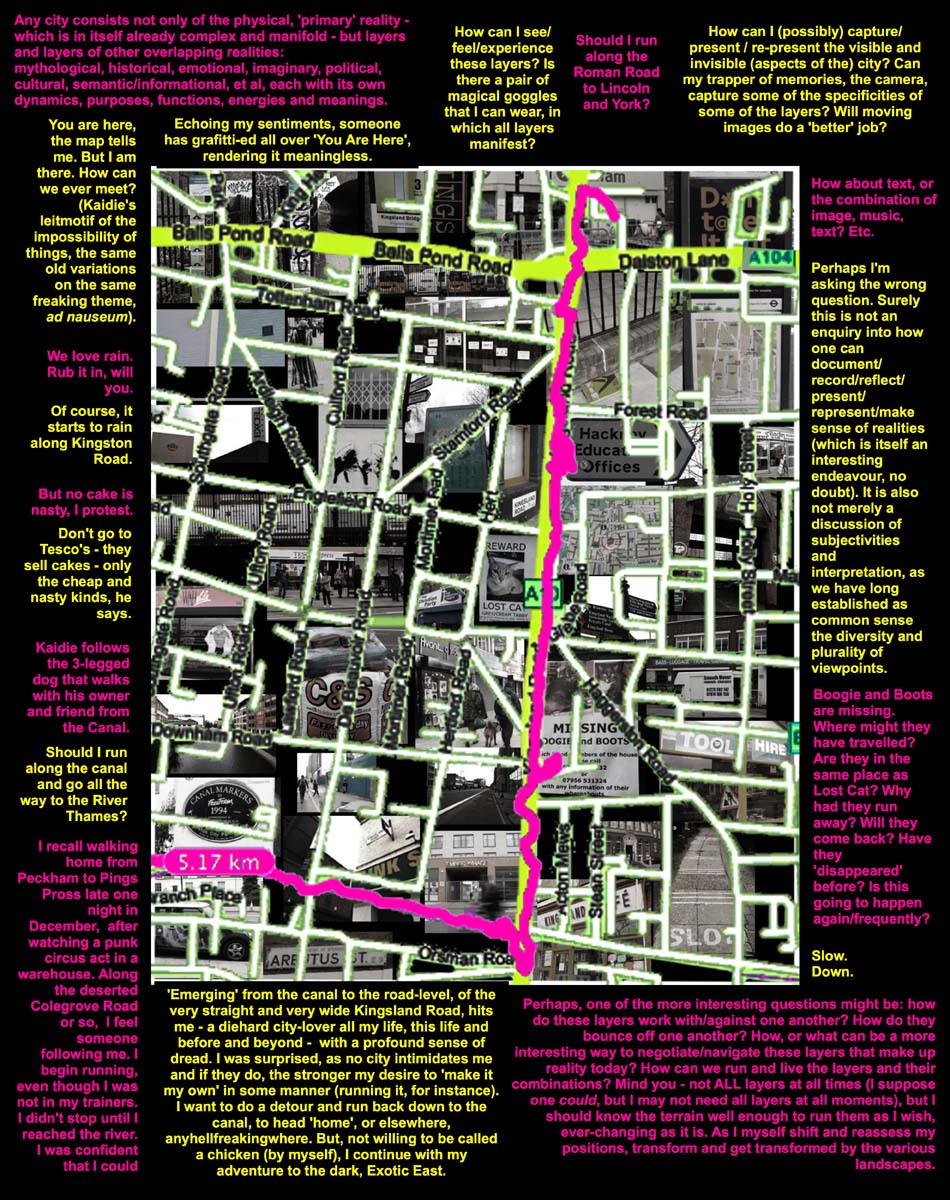 Erratum: ‘I was confident that I could …’ on the left hand corner here at the bottom should read ‘I was confident that I could outrun this person/any one, not because I run fast (Dear Readers, we have been there before, several times), but because I knew that if I kept going, stubbornly, silli-ly, I would, eventually. So I did.’ This sentence should alternatively say, ‘I was confident that I would not run ahead of my bloody sentences and would finish them the next time before I publish anything’. There you/I go.
Erratum: ‘I was confident that I could …’ on the left hand corner here at the bottom should read ‘I was confident that I could outrun this person/any one, not because I run fast (Dear Readers, we have been there before, several times), but because I knew that if I kept going, stubbornly, silli-ly, I would, eventually. So I did.’ This sentence should alternatively say, ‘I was confident that I would not run ahead of my bloody sentences and would finish them the next time before I publish anything’. There you/I go.
DOCUMENTATION OF 3.0, 2.0, 1.0! READY, GET SET, GO! RUN FOR (Y)OUR LIVES! 22 March 2010 performance.
8 minute lecture-performance by Kailives, standing in for Kaidie, on the eve of Kaidie’s 100th day birthday and her continued dis-location. Kailives discusses the philosophy of Life 3.0, and the gap between theory (of Life 3.0) and (Kaidie’s) practice (of her semblance of life). Unbeknownst to Kailives, however, towards the end of the performance, Kaidie makes a brief appearance – right behind Kailives back, on screen!
The performance was filmed by the wonderful performance artist/filmmaker Jayne Parker. Off The Shelf, a 1-night word-image event, was curated by Sharon Morris and Jon Thomson, at the Slade School of Fine Art, University College London, UK, 22 March 2010, Monday. Kaidie’s segment came on at around 2130hrs.
**There was a gap in documentation towards the end of the performance due to tape change**
** There will be an upcoming gig at the end of June in the city of Nondon! For updates, watch this space! For gigs that Kaidie has performed so far, watch that space! **
KAIDIE’S SLIGHT DETOUR/DIVERSION/REALITY CHECK: ON HERZOG’S ENIGMA OF KASPER HAUSER (Catch on BBC iplayer now!)
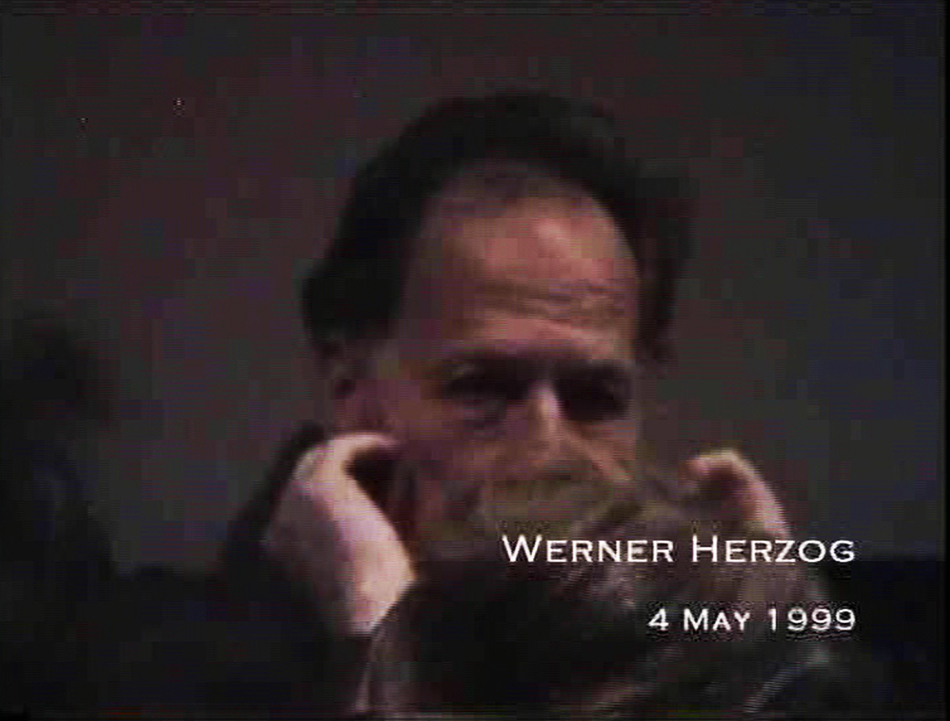
Werner Herzog at the San Francisco International Film Festival, 1999. Frame grab from final chapter of Chlorine Addiction by Kai Syng Tan (2000)
If it wasn’t for this (this tedious 1000-day hell of an ‘epic’ endeavour, of Kaidie’s quixotic running across dimensions in search of the so-called ‘Meaning of Life 3.0’), we could possibly have conducted our research on Werner Herzog, as we had contemplated at some moments of our previous lives. How nice now, in this life, to revisit his The Enigma of Kasper Hauser (1974).
The classic Herzogian leitmotifs are there: beasts (fainting chicken, kneeling camel), outcasts/freaks (myth of tiny king with tiny kingdom, each king tinier than before; Kasper Hauser himself); freak shows (including the film we are watching); dreamscapes (ditto, and Kasper’s flickering Super-8 Sahara dreams); hero/anti-hero (Kasper/Bruno S.); character/actor, acting/not acting (Kasper/Bruno S.); ‘realism’ vs self-mythologisation (including Herzog’s own); the clash of cultures/civilisations (Kasper scrutinised again and again as an Other; “Mother, I have been so cut off from the world”, says Kasper, holding her baby); an assault on ourselves (the Other or the ‘idiot-savant’/savage being more enlightened and more civilised than us); power play and cruelty (boys at chicken and Kasper); moments of tenderness (Kasper playing with black crow, recalling the iconic image of Klaus Kinski playing with monkey in the final scene of Fitzcarraldo); man vs nature (“Let the apples sleep, they are tired.”); man and art (“The music feels strong in my heart. All of a sudden I feel old. Why can’t I play the piano like I breathe?”); godlessness and the absence of redemption (the subtitle, Every Man for Himself, and God Against All of Them, says it all.)
Controversial and problematic as his work and methodologies were/are, Herzog always haunts and provokes, in a manner that is austere, Brechtian and unsentimental as it is acutely Romantic.
In a previous life, I saw the filmmaker speak at the San Francisco International Film Festival. (I had rushed back to the cinema from my tour around San Francisco of Hitchcock’s film locations of Vertigo – the very same tour that Chris Marker took, I am told, to film the passage that pays homage to Vertigo/Madaleine’s ghost, in his Sans Soleil). As usual, Herzog spoke contemplatively, measuredly, in flawless English with his unmistakably charming accent (but he offered an obligatory ‘apology’ for his ‘bad English’ at the beginning of his speech), punctuated with calculated pauses (Is that Herzog narrating the final dream sequence in Kasper?)
Herzog reminds us of many things, and reminds Kaidie the need to keep running and not lose her vision, flickering and faint as they may be at times. (She is short-sighted after all. Time to clean her mouldy glasses.)
A ROUGH GUIDE TO REGENT’S FARK: KAIDIE’S MOOMOODYMOODMOOD MAP OF HER TYPICAL RUN AT HER FAVOURITE FARK.
You can take a look at the same route tracked sehr scientifically using GPS on my page in GPSies – albeit ending up at my local Pesco’s to buy 35 tubs of some of my favourite jellied eel. Starting from last week, however, Kaidie has upped her training to 1 more loop, in preparation for her first ever Life 1.0 marathon in September, making it a total of about 18km under 2 hours each time. More updates about the race soon! Watch this space. Don’t you dare blink.
IT’S DAY 152, AND KAIDIE CERTAINLY HAS MUCH CATCHING UP TO DO. In the midst of trying to make sense of Nondon now/here.
Hello world. Again. I’ve run back to run my own lives. For now.
For the benefit of those of you who have just joined me on my quest, here’s a summary of the events in March and April: On 2 March, while running along Fuston Road, I fell head-over-heals. I dislocated a part of my body. Thereafter, I could not be located. I had been kidnapped by The Good Pirate into the world-within-world-within-world of Phuket 2.0 in Second Life. In my absence, a reader, Kailives, hacked into my account and ran my lives on my behalf, by maintaining this blog, my Facebook Twitter and Youtube pages, as well as standing in for a few of my gigs. I did make brief appearances in some of these events, and that was how my whereabouts was uncovered. Finally, on my 5th-month birthday, I decided to break free from my kidnapper, and left the metaverse.For better or for worse, but for a restless runner, it is certainly not for good.
Kailives did try her best to do my job in my absence. However, in this collaborative quest of the meaning of Life 3.0 of Kaidie’s, there were several issues that her co-runners raised that made Kaidie slightly dumbfounded. Some of them are reproduced in the above image. In the coming weeks and months, I will have to try to think about them and respond to them. So, my dear readers and fellow-runners, thank you very much indeed for all your advice and support so far. Please do be patient and give me some time to carefully look at your advice. Kailives has left, but if need be, I may get her back, if I need her voice.
At this point, however, I can respond loud and clear, in absolutely no uncertain terms, that I will have to say no to the suggestion that Kaidie should make a baby in her quest for the meaning of Life 3.0. Kaidie’s response is NO, no, no thank you, never. No. Kaidie will make no baby. Especially not now, given the way things seem to be heading in Nondon.
TRAVELLING IN THE WORLD-WITHIN-WORLD-WITHIN-WORLD OF THE METAVERSE
 The following is an other one of several imaginary discussions between ‘Pro-First-Lifers’ (realists who value meatspace more than our virtual) and ‘Pro-Second-Lifers’ (Cyber-enthusiasts and those who celebrate the power of imagination), in a fictitious online academic forum. Entitled (How) Does Physics Function In Cyberspace? Metaphysical Enquiries For The 21st Century: An Online Peer-To-Peer Peer-Reviewed Forum, subscribers include very serious philosophers, psychologists, media theorists, writers, cyber-geographers, cyber-artists, cyber-anthropologists and cyber-anybody-else. And very, very serious PhD students. However, it is sometimes unclear which side they speak for. It is also suspected that some of the subscribers may have more than one account and speak from different sides. Like the real world, the online world is not black and white …
The following is an other one of several imaginary discussions between ‘Pro-First-Lifers’ (realists who value meatspace more than our virtual) and ‘Pro-Second-Lifers’ (Cyber-enthusiasts and those who celebrate the power of imagination), in a fictitious online academic forum. Entitled (How) Does Physics Function In Cyberspace? Metaphysical Enquiries For The 21st Century: An Online Peer-To-Peer Peer-Reviewed Forum, subscribers include very serious philosophers, psychologists, media theorists, writers, cyber-geographers, cyber-artists, cyber-anthropologists and cyber-anybody-else. And very, very serious PhD students. However, it is sometimes unclear which side they speak for. It is also suspected that some of the subscribers may have more than one account and speak from different sides. Like the real world, the online world is not black and white …
Since March 2, Kaidie has been running about in Second Life as Kaidie Absent, having been kidnapped by The Good Pirate, a.k.a. Chutha Achavasmit, away from Life 1.0. The images we see here are screen grabs from Kaidie’s Cyberspace Odyssey in the past 2 months.
Perhaps it is about time Kaidie runs out of the Metaverse, and come ‘back’ to run her Life 1.0, Life 2.0 and Life 3.0 by herself.
…
Bruce Damer: The surface area of virtual worlds (if an avatar’s height is taken as a unit of measure) will probably exceed the surface area of the Earth within a couple of years.[1]
Pro-Second-Lifer C: Thanks to the Internet, my world has expanded vastly. Cyberspace is a not only a great place to visit – within there, there are so many more worlds that I can inhabit. The attraction of the virtual worlds of MUDs and MMOGs is how nearly anything is possible, including things I cannot do in Life 1.0, and things that once only belonged to the realms of my imagination in Life 2.0. Thus is their attraction, as their popularity attest. China alone recorded 55.5 million online gamers by 2008, with the total market value for virtual transactions at RMB 10-13 billion[2]. What Damer said in late 1997 with respect to Alpha World is not far fetched (although hitherto unverified, to be sure). According to Edward Castronova, tens of thousands of people are logged on into virtual worlds at a time, 24 hours a day, all year round. And, for many, ‘life in the virtual reality spaces seemed preferable to life on Earth.’[3]
Wagner James Au: On an innovation scale, Second Life suggested the potential for MMOs to also be a development platform for commercial, educational, and research projects. […] In South Korea, an estimated one in twelve members of the entire population have played an MMO called Lineage; in China, a whole cottage industry is devoted to “gold harvesting”, the acquisition of gold coins and other fictional money in MMOs. […] As broadband and high end PCs saturate the international market, it’s time to consider MMOs as the likeliest candidate for the Internet’s next generation, supplanting the two dimensional, semi–interactive portal of the Web for an immersive, three–dimensional, fully interactive Metaverse of data. [4]
Pro-First-Lifer C: I am baffled about these statistics of the happenings in Life 2.0, since I can hardly feel a thing in Life 1.0! What is shocking is how pervasive, in all aspects of Life 1.0, this impact has been! What is even more disastrous to contemplate, is Au’s mad prediction is that this mad fictive world within the already-mad Internet world will become the norm of the Internet! What on earth are the conditions that are behind this exodus, where you, and all the millions of gamers ‘leave the real world behind’[5]?
Edward Castronova: [… ]the industries that produce shared virtual reality environments [are developing] rapidly. Advances in connectivity (bandwidth) and interfaces (haptic devices, heads-up displays) have been driven by technology. The amount of available content (narratives, folklores, backstories) has expanded; the video game industry has begun to surpass the motion picture industry in gross revenues. As the phenomenon continues to grow, the aggregate amount of time devoted to shared virtual reality spaces seems likely to rise from today’s tens of thousands of person-years into the hundreds of thousands or perhaps millions.[6]
Pro-Second-Lifer C: There are no lack of examples of large corporations expanding into Cyberspace and building virtual worlds, such as Sony and Microsoft, and Electronic Arts, which support Sims. [7]
Edward Castronova: The Earth is very nice, but there are experiences we can imagine in our minds that we cannot have here. [8]
Pro-Second-Lifer C: Preferring the term ‘synthetic world’, Castronova defines one as ‘persistent online 3D spaces that replicate many of the features of the real world’. Similar to a video game character, the user negotiates synthetic worlds using a virtual body, known as an avatar. That thousands of people can be in the world at the same time make the environments ‘much like a real place, socially speaking’. The worlds, according to Castronova, ‘have a sort of fantastical yet logical reality to them, such that people can fly, but only if they have wings or a flying spell or happen to be birds to begin with.’[9]
William Gibson: A square of cyberspace directly in front of him flipped sickeningly and he found himself in a pale blue graphic that seemed to represent a very spacious apartment, low shapes of furniture sketched in hair-fine lines of blue neon. A woman stood in front of him, a sort of glowing cartoon squiggle of a woman, the face a brown smudge. “I’m Slide,” the figure said, hands on its hips…[10]
Pro-First-Lifer C: Do you not see the problem? These are much like, as Castronova says, but are definitely not real places. You are looking through what Tim Guest labels an electronic looking glass[11], and everything is distorted! You are going the dark streets, the downward spirals, where you would not have dare even thought of venturing in RL.
Pro-Second-Lifer C: What might the problem be? Take pornography – being highly stylised with its own sets of conventions, no one takes them to be ‘the real thing’, but simulations and performances. No pun intended, but pornography slips in and out of ‘reality’ as we know in Life 1.0, to the extent that it does not even matter if they are real or not. This would be the fictive world that philosopher Daniel Dennett says we do not question in this way, because it is not set out to be approached as such.[12] Reality is not the question. Whether something is real or not, or, for that matter, if it is distortion or not, is not the point. This is no different from your illicit agreement with the rules of cinema, when you enter a movie theatre. While you are in there, within the magic circle, you suspend your disbelief, and for the next 90 minutes watch a similar-looking, albeit also significantly different, world unfold in front of you. And it’s even better in a virtual world, since you can participate in it, and direct it!
Sherry Turkle: MUD players are MUD authors, the creators as well as consumers of media content. In this, participating in a MUD has much in common with scriptwriting, performance art, street theater, improvisational theater, or even commedia dell’arte[13].
Wagner James Au: Unlike most MMOs, Second Life encourages its subscribers (the preferred terms is ‘Residents’) to literally build the world with the construction and programming tools provided for them.[14]
Edward Castronova: A not insignificant fraction of the players of these games reported that they felt themselves to be not game players, but citizens of a new world.[15]
Pro-Second-Lifer C: From a wild, untamed piece of virtual land, entire mansions, towns and cities and be architected, hence increasing my sense of ownership and belonging in these worlds. Like Hiro, I can imprint my virtual addresses on my namecard. With a place to call home, and one I have built (or paid Linden dollars for someone else to build) at that, who wouldn’t want to keep going back back?
Pro-Second-Lifer D: Following Pro-Second-Lifer C’s previous line of thought, Cyberporn is even more attractive than porn, being a simulation-within-simulation, a double-simulation. Similarly, a virtual world, being a world within the world of cyberspace, is a double attraction. Virtual worlds are even better than pornography, since I am not only watching it, but participating in it! Well, very nearly. (Sex within virtual worlds is a topic that warrants long discussions – let us do that in a separate thread.) Hard-core Second-Lifers, such as the Second Life resident journalist Au, even go to the extent of describing cyber-activities outside of virtual worlds, such as emailing and blogging, as belonging to ‘real life’![16]
Wagner James Au: […] the experience of one’s alter ego being in an immersive space is experientially different from any other kind of Net–mediated interface that has come before it. Different, and in several key ways, better, than the limited, distanced, largely asynchronous interactivity of the Web as it exists now. An MMO quite literally offers a direct pathway into data, and global collaboration with an international community through avatars that afford each individual a high degree of anonymity, and paradoxically, an equally high degree of self–representation. With so much potential, and the technical/commercial infrastructure in place to make it feasible, it’s difficult to imagine online worlds not becoming the next real leap in the Internet’s evolution. [17]
Pro-Second-Lifer-D: Au is referring to immersion, that which distinguishes being embedded in a virtual world from other kinds of net-mediated interfaces. There are 2 types of immersions that Computer Mediated Communications (CMC) researchers have identified: ‘perceptual immersion’ and ‘psychological immersion’ (the latter drawing us back to the how we derive pleasure from pornography, the art of simulated pleasure – it is all in the mind). Hard at work as well here is the concept of flow.
Richard Bartle: Virtual world designers view psychological immersion as paramount, considering perceptual immersion to be merely one of many possible means to achieve that end. Immersion is also connected with the psychological concept of flow. […] Flow is an exhilarating sense of control and mastery that can arise from pursuing a focused, goal-driven activity; it’s a deep involvement that transcends distractions and sense of time, leading to an ecstatic state of peak productivity.[18]
Pro-First-Lifer-D: Call a rose by any name – flow and immersion are just fancy ways of saying the old, familiar dirty word: addiction.
Sherry Turkle: Stewart is logged on to one MUD or another for at least 40 hours a week. It seems misleading to call what he does there playing. He spends his time constructing a life that is more expansive than the one he lives in physical reality.[19]
Pro-Second-Lifer C: I do not mean to sound pedantic, but addiction has a physical component alongside the psychological one. The concept of flow, theorised by Mihaly Csikszentmihalyi is a positive and creative one, which refers to the ‘optimal state of experience for the individual is one in which intentions are not in conflict with each other’. [20] This is the state of heightened energy and focus where one could lose track of time. This altered state of consciousness is the same state experienced by a runner on a runner’s high, a person taking drugs or an artist at the peak of creativity.[21] And, if you wish to talk about an old, familiar dirty word, the word, my friend, is not ‘addiction’ but ‘TV’. Dr. Turkle certainly does not think of being in-world as automatically a bad thing.
Sherry Turkle: If the computer is replacing time with peers and parents, that’s not good. But if the computer is replacing television, then that may well be an upgrade.[22]
Pro-First-Lifer D: But Dr Turkle, you do not realise that the computer is the new TV! In 1895, the audience ran away at the sight of the approaching train in the Lumiere Brothers’ projection. And although the premise of Orson Welles’s radio prank was obviously improbable (invasion of aliens – or, for that matter, pancakes), listeners were sent into a panic. TV entered our living rooms and became our windows to the world; now the entire earth is brought to you on your laptop. We were enchanted then by the capability of these shrewd mimetic machines; today, we are still at the stage of enchantment by the Internet and its dark streets. Even better than photography and cinema, we are now able to not only mimic reality, but be more real than real. We need to unpack this simulacra, and like Barthes, track down, in the ‘decorative display of what-goes-without-saying’, the ‘ideological abuse’ hidden there[23] Break the fourth wall, step out of the magic circle and wake up from the evil dream!
Pro-Second-Lifer D: It is clear that not being of this (virtual) world, you cannot understand what we have said about the rules of the game, the ‘laws of nature’ in-world, if you like. Or, you are one of the spoilsports, what we term ‘griefers’ in-world.
Wagner James Au: Griefing is at heart an attempt to violate the implicit social contract needed to sufficiently maintain the consensus reality necessary for an online world to function. By looking for flaws in that implicit agreement, griefers often force the company and the community to examine basic assumptions in its structure — something potentially valuable in itself. […] [But, more] fundamentally, their behavior breaks the world itself, in a way that’s inexplicable from within the context of a world. Again, a shattering of the consensual reality not intended by the owners or the inhabitants, often through external, artificial means. [24]
Pro-First-Lifer D: ‘Consensual reality’? Mr Au, you have been in-world for so long that you are unable to spell properly. ‘Consensual unreality’, more like! How deluded are you! Are you all cultists, dimwits in denial, or simply mad? Or are you all failures of the real world, and hence escape and create alternative realities? Are you all blind wo/men with the elephant, and in Plato’s cave, or rather, Dungeon, as it were?! Nearly half of your lot – 43% – actually believe that what you do in-world is as important as RL, according to a new study. Unbelievable![25]
Pro-Second-Lifer D: What you said about artifice is extremely rich coming from your world as well – so many of your so-called rules are artificial constructs as well. Pick any – gender, sexuality, race, the list goes on. Surely we do not have to go into all that discussion again, for we have moved on. That is why we are here, in-world. And contrary to what you say, we are very much ‘awake’ and sober here, as everyone comes in knowing well that this is an artificial, constructed world, the ultimate Brechtian truth. I also argue that this is a more deliberate life, one that you enter willingly, than the one you are simply thrown into. Hence it is a life of a higher quality than Life 1.0, because you have come in of your own will, and you construct yourself as you like, and live as you wish.
Pro-Second-Lifer C: Pro-First-Lifer D, once again, recall what we said earlier about how much the real world is realising the importance of our Second Lives, by joining in. Au rightly points out the importance of positioning online worlds as a part of the real, echoing Dr Turkle’s reminder for us to take them as more than just games, but to pay attention to what they reveal about us[26]. The director of the USC Annenberg School Centre for the Digital Future, Jeffrey I. Cole, also remind us to pay attention to the Internet as a powerful medium.
Wagner James Au:[ …] [I]t’s time to approach these worlds with the seriousness they deserve — to treat online worlds as an essential, inseparable part of our contemporary experience.[27]
Sherry Turkle: Some are tempted to think of life in cyberspace as insignificant, as escape or meaningless diversion. It is not. Our experiences there are serious play. [28]
Jeffrey I Cole: More than a decade after the portals of the worldwide web opened to the public, we are now witnessing the true emergence of the internet as the powerful personal and social phenomenon we knew it would become The internet has been a source of entertainment, information, and communication since the web became available to the American public in 1994. However, we are now beginning to measure real growth and discover new directions for the Internet as a comprehensive tool that Americans are using to touch the world. [29]
Pro-Second-Lifer D: I shiver at bit at Cole’s last statement though – is he implying an American online invasion?!
Pro-Second-Lifer C: Let’s just ignore his bragging. Pro-First-Lifer D, I have yet more examples of interesting First Life presence in Second Life, which reminds us of the point raised by Dr Dodge about how ideology comes into play in cybergeography. In 2007, news website Islam Online created a virtual Mecca in SL, and in the first Hajj, 7,000 people ‘made the journey without even moving’. Not only does this help to provide some relief to the some annual congestion of two million pilgrims, Island developer Walid Wahba says that this aids to ‘educate both Muslims and non-Muslims about the journey. It shows people what the Hajj is and what we do when we’re there.’[30] And, in somewhat amusingly light parlance, he continues: ‘They can check out the worship of God.’[31]However, as common in RL, conflict and discrimination abound in SL. In this case, griefers plastered up pornography on the building, shouting: “We will not leave this place unless this island is shut and Muslims are out.” [32] In 2006, an Israeli built the first synagogue in SL, which grew into a full Jewish neighbourhood with more than 600 members[33]. This expanded into an Israel Island in the following year. Today, users can visit the Old City, Western Wall, the Church of the Holy Sepulcher and the Dome of the Rock, or ‘float’ in the Dead Sea [34] – sans humiliating manhandling by the ill-mannered Mossads for no less than 5 times during immigration checkpoints. One cannot help but attempt to draw parallels about the Israel’s contemporary presence and expansion online, with its troubled endeavours offline, today and historically. Indeed, when interviewed in 2007, the creator of Israel Island had remarked – in hindsight or with foresight, or perhaps innocently – that ‘Second Life is a combination of the real and the imaginary. This came true in December 2008: when Israel launched its brutal attack on Gaza, people, offline and on, reacted furiously. Au reports first hand, in-world.
Wagner James Au: As the airstrikes pounded Gaza, so did protesters, teleporting into SL Israel, waving flags.[…] [T]he protesters kept coming, and eventually [the creator] felt forced to close all of SL Israel to outsiders.[35]
Pro-Second-Lifer D: To continue with Pro-Second-Lifer C’s point about geopolitics: The government of Singapore, the tiny nation with more than 100% broadband penetration, has even bought land in SL. Given that the island has reached her geopolitical (land reclamation) and safety (aerial) limits for expansion, virtual expansion provides the next best ego boost. The young country may also try to lure new (virtual) immigrants from SL, which boasts a population more than double that of Singapore.[36]
Pro-First-Lifer D: You have presented some stark information here. But I am not convinced that SL and the likes are filled with decadent hairy hippie idealists – that is the foundation after all, is it not? Second Life itself says that it is an attempt at a realization of Stephenson’s Metaverse[37]. Also, Au himself states that ‘[m]uch of the Internet’s development in the ’90s was fueled by the cyberpunk–tinged, Bay Area techno–utopianism of Wired.’[38]
Pro-Second-Lifer C: I have to admit defeat with regards to your point about hippies. They have shaved, put on clothes, tuned in and wired up too. I have to admit that we do have them here. One just can’t shake them off, even in SL… Actually I may even be one of them, but you may never find out. Anyways, do not let a few cultural glitches turn you off. Just like RL, SL has a large diversity of people, and non-people. Just like RL as well, SL has different landscapes and sceneries for every taste and experiment. You could have sex with a horse[39], take part in an anti-Bush protest[40] or become an octopus and rape another octopus, or more radically for an octopus, have sex with, or rape a human being[41]. Au himself boasts of the myriad of pixelated beings that he has interviewed,
Wagner James Au: I’ve interviewed strippers and Catholic priests, combat veterans and peace activists, socialist utopians and midget warmongers. I’ve profiled entrepreneurs who own whole continents and earn six figure incomes from the buying and selling of virtual land, and a homeless hacker who built a virtual mansion while squatting in an abandoned building. [… ]I am talking about seeing the citizens of online worlds as a cross–section of the world itself. […[ And even though none of these events or persons really exist, except as data bits in a San Francisco server farm, they’re part of the best story I’ve ever been lucky enough to cover as a journalist. Because I’ve come to believe that it’s an inadvertent advance report on the future of the Internet, and how we’ll interact in it in decades to come. [42]
Pro-First-Lifer D: You need a reality check. In fact, I am going to leave this forum right now and return to Life 1.0. Get a Life 1.0, you.
Moderator: Discussion closed.
This was sketched in January 2010. Obviously, some things, including Kaidie’s grasp of things and her own position, have moved on. We are just uncertain if the ‘moving on’ is a progression, regression, or an other loopy trip).
[1] Bruce Damer, author of Avatars! Exploring and Building Virtual Worlds on the Internet in late 1997, quoted in ‘To Thine Own Selves Be True: Review of Sherry Turkle’s Life on the Screen’, Introduction to Computers and Technology: Electronic Resources Center [accessed 25 December 2009].
[2] ‘JLM Pacific Epoch – CNNIC: China Has 55.5M Online Gamers’, JLM Pacific Epoch, 2009 [accessed 5 January 2010].
[3] Edward Castronova, ‘Theory of the Avatar’, SSRN eLibrary, 2003 [accessed 4 January 2010].
[4] Au, Taking New World Notes. [accessed 30 December 2009]
[5] Tim Guest, Second Lives, Arrow Books, 2007, p. 9.
[6] Castronova, ‘Theory of the Avatar’.
[7] Castronova, ‘Theory of the Avatar’.
[8] 2005, p. 25, quoted in Freund.
[9] Edward Castronova, Synthetic Worlds: The Business and Culture of Online Games (University Of Chicago Press, 2006), p. 1.
[10] William Gibson, ‘Count Zero’, Voidspace, 1986 [accessed 5 January 2010].
[11] Guest, p. 1.
[12] Daniel Dennett, ‘The Self as a Center of Narrative Gravity’, in Self and Consciousness, ed. by F. Kessel and D. Johnson (Hillsdale, NJ: Erlbaum, 1986), pp. 275-88 [accessed 5 January 2010].
[13] Turkle, ‘Who Am We?’ [accessed 30 December 2009]
[14] Au, ‘Taking New World Notes’.
[15] Castronova, Theory of the Avatar.
[16] Au.
[17] Au.
[18] Quoted in Michael Hohl, ‘A Glossary for Interactive Technologies’, Hohlwelt, 2009 [accessed 5 January 2010].
[19] Turkle.
[20] Quoted in Hohl.
[21] Mihaly Csikszentmihalyi, ‘Flow’, TED talks, 2004 [accessed 22 November 2009].
[22] Technology Review, ‘Life On Line – S. Turkle Interview’, Pol.it: The Italian on line psychiatric magazine, 1996 [accessed 22 December 2009].
[23] Roland Barthes, Mythologies, Later Printing (Farrar, Straus and Giroux, 1972).
[24] Au.
[25] ElectricNews.net, ‘Second Life equal with First Life •’, The Register, 2006 [accessed 5 January 2010].
[26] Turkle, ‘Who Am We’.
[27] Au.
[28] Turkle, ‘Who Am We’.
[29] ElectricNews.net.
[30] ‘Second Life Visit To Mecca For The Hajj’, Sky News: Technology, 2007 [accessed 22 December 2009].
[31] ‘Second Life Visit To Mecca For The Hajj’. Italics mine.
[32] ‘Second Life Visit To Mecca For The Hajj’.
[33] Megan Jacobs, ‘Second life Israel | Internet and Technology | Jerusalem Post’, Jerusalem Post, 2008 [accessed 22 December 2009].
[34] Jacobs.
[35] Wagner James Au, ‘New World Notes: Disputed Territory: War in Gaza Provokes Protest (And Conversation) In Second Life Israel’, 2009 [accessed 22 December 2009].
[36] Nicholas Aaron Khoo, ‘Come to Singapore in your Second Life! – CNET Asia Blogs: Geekonomics’, CNET Asia, 2007 [accessed 5 January 2010].
[37] Au, Taking New World Notes.
[38] Au, Taking New World Notes.
[39] Xah Lee, ‘Animal Love in Second Life’, A Tour In Second Life, 2007 [accessed 29 December 2009].
[40] Au, Taking New World Notes.
[41] Xah Lee, ‘Forced Play in Second Life’, A Tour In Second Life, 2007 [accessed 29 December 2009].
[42] Au, Taking New World Notes.
ON 19 APRIL, KAIDIE ABSENT AND HER KIDNAPPER, CHUTHA INDIGO, HAD A VISITOR, MONO FUGUE, IN PHUKET 2.0.
Since March 2, Kaidie has been running about in Second Life as Kaidie Absent, having been kidnapped by The Good Pirate, a.k.a. Chutha Indigo, away from Life 1.0. On 19 April 2010, they had a visitor Mono Fugue a.k.a. Monologues, in Virtual Phuket, which is built by Chutha Indigo. And what fertile ground for getting disoriented: Phuket, a beach resort in Thailand vs. Phuket 2.0; Gavle, Sweden vs. Nondon, UK; GMT 14:30-19:30 vs. GMT+1 in Sweden vs. SLT 06:30-11:30; experience vs. imagination; memory of actual visit to Phuket 1.0 vs. (re)visit of Phuket 2.0; online vs. being disconnected; immersion vs. distance; tropical sunset vs. still-frigid Gavle; catching a bus in Life 1.0 vs. flying, gravity-free, in Life 2.0; panting in RL vs. coffee-sipping in SL. The following is a reflection written by Mono on his experience.
Nausea (or how I learned to love getting lost and finding myself in a pattern again)
Fourteen years ago I had my first encounter with a high speed internet connection. People in my surrounding rarely used internet and barely had any meaningful use of computers. Five megabytes was a very big file and digital camera photos were stored on 1.44 Mb floppy disks. At this time I was determined to become a future space cowboy, found rocket science a dream but language studies a hell. Little did I know that my perception of this would shortly flip and pretty much lay out a road that I’ve been following ever since.
Text-based chat room, from which I was wired to the world extended my known borders from the small village I was living in to some form of metaphysical realm I could only see but not touch. Yet, like an addict my hunger grew for this super-speeded (back then) information overload, and oh what a fascination that was! Just the knowledge I was sharing the same space with an interesting girl from Tasmania to a shaman somewhere in the U.S. blew my mind. In contrast my village shrunk and I pretty much lost any interest in what it had to offer.
One day I heard of an online project, or yet more, like a community in a virtual world, called Alphaworld caught my attention in an instant. It offered a graphical landscape in which you could move around, build houses and interact with the other habitants (sounds familiar?). Now, my school back then disallowed the students to install any programs (as alpaworld required) and to tell you the truth, computer power was not exactly magnificent back then. I didn’t even own a computer back in 1996, and when I later got one it had a 16 greyscale screen, began coding websites in black and white and doing Photoshop work in.. eh.. greyscale. So what happened with Alphaworld then? The closest I got was connecting to this promised land with a 28.8K dial-up modem from my friends house (in the same village) who’s parents just spend one months salary on getting the latest 66 MHz PC. Alphaworld turned very distant as my presence in this virtual world was limited to a 1 frame per minute refresh rate. My only memory from this world became a printed map, a Mondrian-type pattern which completely drenched the paper with bubble-jet ink.
Fourteen years, some hundred hardcoded websites, programming and complex video editing skills, two new languages, a college degree and thousands of hours in front of flickering screens and a lifetime later I’m sitting on a bus to the same village. In my lap I have enough computer power to make Sputnik literally a blip in space, radiated by 16.8 million colors in my face and a mobile broadband connection through an iPhone I have never ever been as wired as I was that day. Despite the fact that I’m in eternal love with landscapes speeding by, have a fetish for airplane take-offs and living with a constant urge to get geographically lost there are moments I rather just make my trip from a to b in an instant. This day I would however spend my time in a different way, being invited to a meeting in Second Life seemed a rather pleasing experience and a way to make my journey a bit closer to that sensation of instant teleportation. Taking into account I had no greater interest in what this virtual community had to offer I was still surprised of the resemblance to my nostalgic Alphaworld. Except, this time I was physically moving my body, yet largely unaware of what was actually going on around me. My eyes and ears were wired to another space. While I was traveling down the highway between two Swedish cities I was mentally visiting the Thai island of Phuket. Emotions were sparked as I recognized places I have physically been in or had some sort of memories connected to it. While hovering above the virtual soil of Phuket in spherical photo realistic representations, jumping from one gallery to another, one virtual space to antother, while sipping from my virtual coffee cup, the bus driver drove me some 25 kilometers. The time-space continuum seemed to have broken apart as it only exists as a hiatus in my mind. Instead, my physical bus-ride in Sweden now only carries the memory of a visit to Phuket with a pleasant coffee/gallery/chat-session with Kaidie Absent and Chutha Indigo.
Projecting myself to Second Life while letting my body stay in First Life was however not a painless experience. Having the sensation of a nearly related astral projection; traveling without moving (or in reverse) triggered a weird kind of nausea… being there, but being here, but being there. I was not entirely physically disconnected, yet completely wired, and absolutely mentally in another space, floating in a liminal realm of inbetween-ness. At some point I thought to myself, is this how it feels to be born into a new world, you panic at first, have no idea what it is that you see nor how far away the walls or borders of the world are… and slowly vectorized graphics build up a world around you and you get a sensation of a relation to it, which is a slow progress in itself getting acquainted with what there is. The difference here, getting born for the second time, is that the prerequisites for living a second life, in one way or another, forces you to abandon the life you came from. A moment later you switch back and ask yourself, where does my first life end and where does my second life continue? Where do I start, where do I begin in my journey 3.0?
Guest post by Michael Larsson. Michael Larsson is a visual composer who experiments with photography, video, motion graphics or any other (non) electronic method to manipulate light and visuals. Michael’s presence in Life 2.0 can be found on his Website, as well as his Twitter and Vimeo pages. The image on top is created by Michael, while the images below have been captured by The Good Pirate, a.k.a. urban planner Chuthatip Achavasmit.
WHERE IS THAT ‘SPACE’ IN CYBERSPACE? (HOW) DOES PHYSICS FUNCTION IN CYBERSPACE? Where did we come from? Where are we now? Where (the hell) are we off to?
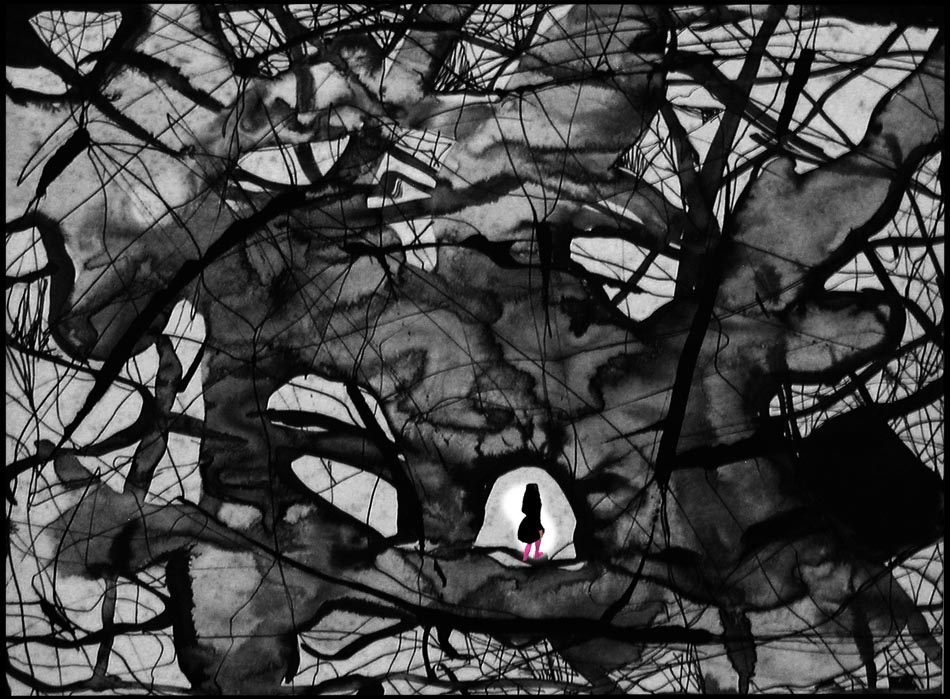
Should Kaidie use this map to plot her escape from her kidnapper in Second Life? After all it's been nearly 2 months since she's been there!
The following is one of several imaginary discussions between ‘Pro-First-Lifers’ (realists who value meatspace more than our virtual) and ‘Pro-Second-Lifers’ (cyber-enthusiasts and those who celebrate the power of imagination), in a fictitious online academic forum. Entitled (How) Does Physics Function In Cyberspace? Metaphysical Enquiries For The 21st Century: An Online Peer-To-Peer Peer-Reviewed Forum, subscribers include very serious philosophers, psychologists, media theorists, writers, cyber-geographers, cyber-artists, cyber-anthropologists and cyber-anybody-else. As in real life forums, participants are civilised – most of the time. Subscribers who identify themselves as a Pro-First-Lifer see Life 1.0 as the more important life, warn us of the dangers that lurk in Cyberspace, and view the Pro-Second Lifers as delusional dreamers who run away from problems they have in RL. Some of them also pelt names like ‘Stelarc Nutters’ and ‘Technogeeks’ at them. On the other hand, the pro-Second-Lifers retaliate by calling them names such as ‘Luddite’, ‘Academics who-are-pretend-Liberalists-but-are-actually-Fascists-in-real-life-Who-Diss-Everything-Because-It-Is-Uncool-Not-To’, ‘Conservatives’ and ‘Amish’. While many subscribers chose to hide behind generic avatars, some bravely use their real names (such as Sherry Turkle, Lev Manovich and Martin Heiddeger). That said, it is sometimes unclear which side they speak for. It is also suspected that some of the subscribers may have more than one account and speak from different sides. Such is the nature of any debates, especially online ones…
Let us begin our Cyberspace Odyssey.
Neal Stephenson: Like any place in Reality, the Street is subject to development. Developers can build their own small streets feeding off of the main one. They can build buildings, parks, signs, as well as things that do not exist in Reality, such as vast hovering overhead light shows and special neighbourhoods where the rules of three-dimensional spacetime are ignored.[1]
Pro-Second-Lifer A: This is an extraordinary time to be alive. Not only can I travel to different cities in real life (RL), there are even more travels I can have outside of RL. Thanks to the Internet, my world has expanded vastly. Cyberspace is a not only a great place to visit – within there, there are so many more places to enter. In Stephenson’s imagination, a metaverse is a ‘place’, with ‘streets’. In Gibson’s, it is a big neon ‘city’, within which there are many centres to visit. But the land size of Second Life alone, at 1,700 virtual square km, is larger than metropolitan London.[2] So it would not be a stretch, even, to describe Cyberspace as a world, within which there are yet many worlds to explore.
William Gibson: People jacked in so they could hustle. Put the trodes on and they were out there, all the data in the world stacked up like one big neon city, so you could cruise around and have a kind of grip of it, visually anyway, because if you didn’t, it was too complicated, trying to find your way to a particular piece of data you needed.[3]
Neal Stephenson: Hiro is approaching the Street. It is the Broadway, the Champs Elysees of the Metaverse. It is the brilliantly lit boulevard that can be seen, miniaturized and backward, reflected in the lenses of his goggles. It does not really exist. But right now, millions of people are walking up and down it.[4]
Pro-Second-Lifer B: Even when simply cruising around as Gibson does, surfing in cyberspace can be akin to psychogeographical tactic that the Situationists advocated in the streets. In these trips, surprises happen, bringing me to unexpected places. When I open my customised homepage on my Firefox browser, I may see a CNN news headlines that I click into to read; there, I may see comments written in by a viewer. Intrigued by her words, I check out her linked Blogspot blog. There, a Google ad pops up to tell me to check out a related topic, which I do, and at the same time, watch a Youtube posting by the same writer, at the same time! I write in a comment to her video, and seconds before I know it, someone else has already responded to my comment. So, another thing that makes my around-the-(Cyber)world-trip better than a RL one, is its simultaneity and real-time quality. It is as if I am visiting London, New York, Shanghai and Johannesburg at the same time! Better still, this world seems to be infinite, with no limits, capable of unending expansion. Like Columbus discovering virgin territories in the 15th century, Web 2.0 is our golden age of exploration, of Cyberspace. As not only a user but a content-creator myself with the easy-to-use tools, not only can I participate in the various virtual worlds, I can construct my own new territories.
Pro First-Lifer A: I might not have the guts to say this to you face–to-face, but I think you are being naïve, crass and Romantic. You are speaking of Cyberspace as if you are Alice entering Wonderland the first time, still in the state of enchantment. In the past two decades, the academic world has been up to speed with this – if not entire new departments like Informatics, there are new divisions in every discipline, such as digital anthropology or ethnography in the ‘old’ discipline of Anthropology, ‘new’ media art in Fine Art (which is by now rather old, so old that artists have dropped the ‘new’ out of embarrassment). This may disappoint you, but there is even the new discipline of Cybergeography – where geographers attempt to fully map the space that you describe as ‘infinite’. The same way psychoanalysts in Life 1.0 rationalise your dreams in your Life 2.0, Cybergeographers conduct their field work online, in-world, and share their data with us in Life 1.0. I am very sorry, but it is time to wake up from your (wet) dreams and have a reality check.
Martin Dodge and Rob Kitchin: The hype around much of Internet, especially in the mid 1990s, was that it was ‘everywhere and nowhere’ and it would make geography less significant in human organisation through the ‘death of distance’. This is patently not been the case. While the Internet has undoubtedly had an affect on the geography of business operation and individual consumption, distance is not dead. What is being witnessed is a complicated restructuring, through processes of concentration and decentralisation, across scales.[5]
Pro-Second-Lifer B: I do not disagree with Dr Dodge and Dr Kitchin. As we invent and use it, we also struggle to make sense of the complex medium. Just as we can approach life itself from different perspectives such as biology, religion and the arts, so, too, could Cyberspace be analysed from various ways. In fact, the penetration of the Internet on our lives is so far and deep, that it is as complex as life itself. And as Pro-First-Lifer 1 pointed out, pre-internet phenomena, disciplines and objects create neologisms, insert hyphens to join the new wave (e-commerce, iphone, Government 2.0); all offices, schools, libraries and institutions in First Life have an equal or even bigger Second Lives online (BBC’s iPlayer, tiny country Maldives as the first country to open its official embassy in Second Life in 2007[6]). Many brick-and-mortar businesses have also found it more efficient to have only virtual offices. So this is a complex stage of re-structuring and paradigm shifts indeed, as First Life attempts to be up to speed with the Second in Cyberspace, in order to fully make use of the powerful medium of the Internet.
Pro-First Lifer A: Check out my government’s website- on the page entitled ‘Social Media and Web 2.0 in Government’, the White House even has a tagline of ‘Better websites, better government’[7]! Recall too how part of Obama’s success during the election was because of his team’s ability to exploit the medium, being pervasive on Youtube and Twitter. So this is a case in point of an clever integration of our First and Second Lives.
Pro-Second –Lifer A: I’m confused though – should it not be the other way around? Better government, therefore better websites? … Anyways, let’s not digress from the discussion of the geography of Cyberspace that Dr Dodge and Dr Kitchin are trying to explain. In any case, no offence to Pro-First Lifer 1, but we certainly don’t need more of this country’s presence in our Second Lives, or of this country’s ‘exploitation’ of anything, for that matter, which we have in our First Lives. Way more than enough. Do not get me started.
Martin Dodge and Rob Kitchin: The idea of the Internet as being somehow ‘anti-geographical’ is based on three key notions: fantasy, denial, and ignorance: 1. Internet geography was assumed not to exist. This is anti-corporeal, cyber-utopianist fantasy that somehow the virtual communities of cyberspace can be produced in a realm divorced from material existence. 2. Internet geography was assumed not to be important, so could be denied. The failure of many e-commerce ventures in the dotcom boom, we would argue, was based in part on ignoring the grounded, geographic, realities of computer-mediated communication, logistic networks and labour markets. 3. Internet geography was assumed not be measurable. Because it was hard to do, it was ignored, especially in the heady days of bubble growth. The medium of communication might be virtual, but the Internet is dependent on physical infrastructure and human labour, most of which is invisible to users. The computers are small in scale and are usually hidden from view in anonymous servers rooms and secure, windowless buildings, while the cables are under floors, in ceilings and in conduits buried under roads. The banal technicalities of Internet infrastructures are easily overlooked (just like for other essential utilities of water, electricity) but they are not naturally given. The geographical structure and operation of networks that service modern living have politics.[8]
Pro-Second Lifer B: Dr Dodge, could you give an example please about the political nature of geography?
Martin Dodge: Domain names are important locational tools at a technical level, but also have a wider political geography in terms of how they are allocated and how this naming relates back to real-world territorial and jurisdictional boundaries. (For example, the recent ruling from a French court that the Yahoo Internet service must block users in France from buying Nazi memorabilia through the web.[9]
Pro-First-Lifer A: Just as there is geopolitics in the real world, there is cybergeopolitics as well. Let us discuss this in a later thread. Pro-Second Lifer 1, your Cyberbubble may burst if you come to my country and see Second Life’s 700 Debian Linux servers in a San Francisco data warehouse[10] – large, physical metals with lots of cables, all working furiously to generate your fantasy world. Just because you do not see them, you are blind also to their presence. And, by the way, if you do not already know, but this is a democratic society, so I have the right to free speech. Or, do you come from a repressed country with dismal human rights records? Have they blocked your Google search engine from the words ‘democracy’ and ‘freedom’ like the Chinese, or even ‘Life’ itself? Or, are you an oppressed Chinese yourself? I am a little busy saving the (real) world, but shall I liberate you as well?
John Perry Barlow: Whether by one telephonic tendril or millions, they are all connected to one another. Collectively, they form what their inhabitants call the Net. It extends across that immense region of electron states, microwaves, magnetic fields, light pulses and thought which sci-fi writer William Gibson named Cyberspace.[11]
Pro-Second Lifer A: The knowledge of the existence of hardworking machines running my Second Life in no way disrupts my enjoyment in-world. Incidentally, artist group Tsunami precisely attempted to question the meaning of distance in their presentation at Documenta 11, by walking from Kassel to Kiev, where Documenta’s servers are located.[12] Understanding that the workings of the dream machine of Hollywood studios, and for that matter, the behind-the-scenes of a blockbuster movie, can enhance my pleasure of the fictional world that is created. And even more so, arguably, in virtual worlds such as Second Life, since I am responsible for creating it! Like Pygmalion, can’t I help but marvel at my own creation! To return us to the topic of geography, I think it is a good idea to have a map around Cyberspace. GPS navigators, maps, Googlemaps and Google Earth certainly help and do not diminish the adventurer’s pleasure in her explorations. Magellan, with his crappy, low-tech compass (high tech at that time, to be sure), was the first to travel around the world, and went all the way to the Philippines (and got killed there, however, god bless his soul). In Cyberspace, search engines are already performing the function of helping one get oriented. Pro-First-Lifer A, answering you question, yes I am Chinese, but not that kind. What kind I am is none of your business. I think the Moderator of this forum should ‘liberate’ you and let you go. Like your country, you are uncivil. I must say that I find you repulsive.
John Perry Barlow: Cyberspace, in its present condition, has a lot in common with the 19th Century West. It is vast, unmapped, culturally and legally ambiguous, verbally terse (unless you happen to be a court stenographer), hard to get around in, and up for grabs. Large institutions already claim to own the place, but most of the actual natives are solitary and independent, sometimes to the point of sociopathy. It is, of course, a perfect breeding ground for both outlaws and new ideas about liberty.[13]
Bruce Sterling: Cyberspace is the ‘place’ where a telephone conversation appears to occur. Not inside your actual phone, the plastic device on your desk. Not inside the other person’s phone, in some other city. The place between the phones. […] [I]n the past twenty years, this electrical ‘space,’ which was once thin and dark and one-dimensional—little more than a narrow speaking-tube, stretching from phone to phone—has flung itself open like a gigantic jack-in the- box. Light has flooded upon it, the eerie light of the glowing computer screen. This dark electric netherworld has become a vast flowering electronic landscape. Since the 1960s, the world of the telephone has cross-bred itself with computers and television, and though there is still no substance to cyberspace, nothing you can handle, it has a strange kind of physicality now. It makes good sense today to talk of cyberspace as a place all its own[14].
Martin Dodge: [Cyberspace] suggests that we can exist in a digital ether. But these dreams are nowhere near reality, for cyberspace is hardly immaterial in that it is very much an embodied space. […] [I]t should be treated as an extension of the geographic realm, not as some disembodied, parallel universe. Nevertheless, cyberspace is changing geography, it is warping space, shrinking distance, and modifying our sense of place. Understanding these complex warpings and distortions is very much at the heart of cybergeography.[15]
Pro-Second Lifer B: Cyberspace, conceptualised in science-fiction of Life 2.0, is now brought back to the material world of Life 1.0 by Cybergeographers. While the realists or academics measure Life 2.0 with the rules of Life 1.0, Residents of Life 2.0 continue to attempt to push their limits of imagination and go deeper, further. While Dr Dodge maps Cyberspace as an ‘extension of the geographic realm’, Pro-Second Lifers like myself and Turkle’s MMOG player Doug would have mapped physical geography as an extension of Cyberspace, the same way he sees RL as another window in his desktop. In a similar vein, we can see our online existence as an extension of our physical existence, since many of us have email ‘addresses’ and ‘home’ pages, apart from an address and home in a physical location.
John Perry Barlow: Cyberspace is the homeland of the Information Age – the place where the citizens of the future are destined to dwell.[16]
Neal Stephenson: HIRO PROTAGONIST: Last of the freelance hackers/ Greatest sword fighter in the world/ Stringer, Central Intelligence Corporation / Specializing in software-related intel (music, movies & microcode). On the back is gibberish explaining how he may be reached: a telephone number. A universal voice phone locator code. A P.O. box. His address on half a dozen electronic communications nets. And an address in the Metaverse.[17]
Pro-Second-Lifer B: Like Stephenson’s Hiro Protagonist, our namecards can provide an address in the Metaverse rather than the physical – which in any case is becoming increasingly insignificant, given the death of the culture of letter-writing in preference of email (or briefer still, 140 characters). If we look at the larger picture, Cyberspace – not Earth – is our destined homeland, as Barlow tells us. Also, given that content is user-generated and emergent – by that I mean that which arises and exists only as a phenomenon of independent parts working together, and that which is not predictable on the basis of their properties[18] – there really seems to be more places that we can build, faster than the Cybergeographers are able to map them. The tension between Life 1.0 and Life 2.0 imaginations of the geography of Cyberspace is extremely interesting, just as the tension between Life 1.0 and Life 2.0 imaginations of of any aspect of life (identity, politics, behaviour, reality) and indeed, Life itself, extremely rich.
Pro-First-Lifer B: Pro-Second-Lifer B, you speak of the changes in Cyberspace as if human and natural geographies are static! In response to the changes in physical geography, new maps – and more importantly, new methods of thinking about mapping- are constantly generated. And, in this age, no one is so naïve as to assume that maps are transparent, neutral or objective, but are dynamic mappings.[19] Ditto Cyberspace! I also strongly advise you to have a look at Dr Dodge and Dr Kitchin’s wonderful book, Atlas of Cyberspace, which contains many mappings of many facets of Cyberspace, including maps of the structure of cyberspace, maps of the Web, maps of emails and virtual worlds, as well as an entire section of imaginations from the arts, including science fiction[20]. The existence of this book itself is proof enough of the Cybergeographers recognition of the diversity and wealth of Cyberspace.
Rob Kitchin and Martin Dodge: Maps are never fully formed and their work is never complete. Maps are transitory and fleeting, being contingent, relational and context-dependent; they are always mappings; spatial practices enacted to solve relational problems (eg, how best to create a spatial representation, how to understand a spatial distribution, how to get between A and B, and so on). [21]
Pro-Second-Lifer B: Thank you for the lead, I will definitely read that. I think we recognise that our quarrel about the gap between what we imagine (Life 2.0) and what we translate into reality (Life 1.0), belongs, in part, to the old debate of Cartesian anxiety. As a Pro-Second-Lifer, I certainly am in the ‘mind’ camp. Speaking of which, children certainly have very interesting imaginations of geography on- and off-line. Sherry Turkle talks about how children think of their creations in MMOGs coming to live, and travelling outside of their metaverse into cyberspace![22]
Sherry Turkle: Robbie, a 10-year-old who has been given a modem for her birthday, puts the emphasis not on communication but on mobility in considering whether the creatures she has evolved on SimLife are alive. […] if your modem were on, [the creatures] could get out of your computer and go to America Online. […] Sean, 13, who has never used a modem, comes up with a variant on Robbie’s ideas about travel. “The creatures could be more alive if they could get into DOS. If they were in DOS, they would be like a computer virus and they could get onto all of your disks, and if you loaned your disks to friends, it would be like they were travelling.”[23]
Pro-Second-Lifer A: And don’t we forget that it was, again, Google Earth – the powerful tool of military precision that raises concerns of privacy for the Pro-First-Lifers – is founded in science fiction as much as Jeremy Bentham’s panopticon. We don’t need to fly up the skies or outside of earth itself, to now have a bird’s or god’s eye view. Don’t we see the importance of Life 2.0, with its rich imaginations, supplying Life 1.0 with Life itself!
Neal Stephenson: There is something new: A globe about the size of a grapefruit, a perfectly detailed rendition of Planet Earth, hanging in space at arm’s length in front of his eyes. Hiro has heard about this but never seen it. It is a piece of CIC software called, simply, Earth. It is the user interface that CIC uses to keep track of every bit of spatial information that it owns — all the maps, weather data, architectural plans, and satellite surveillance stuff. [24]
Pro-Second-Lifer A: The MMOG Second Life begins as a vast landscape of untamed wilderness, that the Resident has to sculpt, shape, and settle. Just as RL, SL has different landscapes and sceneries for every taste and ambition – if one has enough Linden dollars, that is.
Wagner James Au: From open oceans spring sailboats, submarines, and cruise ships; from the plains come racing tracks, clothing–optional nightclubs, and Resident–made games of all size and style. From the mountains appears sprawling, Frank Lloyd Wright–style homes, tree villages, and heavily–armed World War II fortresses. In all this, there’s a distinct sense of an expanding wilderness being settled. [25]
Pro-First-Lifer A: You have a great sense of irony – the irony however is that you do not know it. You claim that ‘Life 2.0 supplying Life 1.0 with Life itself’ – do you not see that in your own formulation, Life 1.0 is the larger entity, with Life 2.0 a little grapefruit within it? And, my dear Pro-Second Lifer A, the ‘A’ in my avatar refers to my Almighty country, but I suppose yours refers to A***hole.
Moderator: Discussion thread closed due to Antagonistic behaviours of some users.
(This was sketched January 2010. Obviously, some things, including Kaidie’s grasp of things and her own position, have moved on. We are just uncertain if the ‘moving on’ is a progression, regression, or an other loopy trip).
[1] Neal Stephenson, Snow Crash (Spectra, 2000), pp. 24-25. (Chapter 4)
[2] Freund, Katie, ‘DIGC101 Online Worlds’, 2009 [accessed 2 January 2010].
[3] William Gibson, Mona Lisa Overdrive, (Spectra, 1989), p. 22.
[4] Stephenson, p. 24 (Chapter 1), Snow crash.
[5] Martin Dodge and Rob Kitchin, ‘Net: Geography Fieldwork: Frequently Asked Questions’, CASA: Working Paper Series, 83 (2004).
[6] ‘Tiny island nation opens the first real embassy in virtual world – Times Online’, Times Online, 2007 [accessed 22 December 2009].
[7] USA government, ‘Better websites. Better government: Social Media and Web 2.0 in Government’, WebContent.gov:, 2009 [accessed 4 January 2010].
[8] Dodge and Kitchin.
[9] Martin Dodge, ‘Cybergeography’, Environment and Planning B: Planning and Design 28(1) 1-2, 2001 [accessed 4 January 2010].
[10] Tim Guest, Second Lives (Arrow Books Ltd, 2008), p. 7.
[11] John Perry Barlow, Crime and Puzzlement, 1990. Quoted in Dodge, The Geography of Cyberspace Directory – What is Cyberspace ? [accessed 26 December 2009].
[12] Tilman Baumgartel, ‘[Reader-list] A different take on Documenta 11’ [accessed 4 January 2010].
[13] John Perry Barlow, Crime and Puzzlement, 1990. Quoted in Dodge, The Geography of Cyberspace Directory – What is Cyberspace? [accessed 26 December 2009].
[14] Bruce Sterling, Introduction to The Hacker Crackdown.
[15] Dodge 2001, ‘Cybergeography’, Environment and Planning B: Planning and Design 28(1) 1 – 2 .
[16] 1991, quoted in Dodge.
[17] Stephenson, Snow Crash.
[18] Apple Macintosh Dictionary function, version 2.0.3 (51.5).
[19] Rob Kitchin and Martin Dodge, ‘Rethinking maps’, Progress in Human Geography, 31 (2007), 331-344 [accessed 5 January 2010].
[20] Dodge and Kitchin.
[21] Rob Kitchin and Martin Dodge, ‘Rethinking maps’, Progress in Human Geography, 31 (2007), 331-344 [accessed 5 January 2010].
[22] Turkle, 4.01: Who Am We?
[23] Turkle, 4.01: Who Am We?
[24] Stephenson, Snow Crash. Chapter 13.
MEIFUMADO by M4SK 22, ‘INSPIRED BY A MEETING WITH SOMEONE WHO DOESN’T EXIST’. Thank you M4sk 22 for inspiring us with a lively and life-affirming work! Let’s keep running together.
Meifumadô by M4SK 22, April 2010.
IN THE WORDS OF M4SK 22:
‘Keep Running, Keep Dreaming, Keep Believing… Music and video by M4SK 22. Inspired by the selfless journey of Kaidie http://kaisyngtan.com/3rdlifekaidie. Footage from Princess Iron Fan, the first Chinese animated feature film, made by Wan Guchan and Wan Laiming (the Wan brothers) and released on January 1, 1941. The story was liberally adapted from a short sequence in the popular Chinese folk tale Journey to the West. Meifumadô (land of the demons) is also the title of the 5th Kozure ?kami (lone wolf and cub) film.’?
ABOUT M4SK 22:
M4SK 22, a sound and vision project by Simon Woolham and David Moss: ‘Artists making music with whatever we can get our hands on. Mixing acoustic and electric instruments roots, soils and dusts, samples and software, in a desire fired sonic crucible.’
Follow the work of M4SK 22 in Myspace, Blogspot, Twitter, Youtube and Vimeo.



